Sunday, April 30, 2006
HAPPY BIRTHDAYS!
1933 - Singer, songwriter, Farm Aid founder, Willaim Hugh "Willie" Nelson is born in Abbott, Texas
1934 - Jerry Lordon, composer of "Apache", the first big hit for the UK's The Shadows, was born in London
ON THIS DAY IN CAPITOL RECORDS HISTORY
1928 - Ten year old Stubenville, Ohio native Dino Crocetti (Dean Martin) had his first Holy Communion and took the name Paul as his confirmation name
1947 - Mel Blanc is in the studio to record the track "Porky Pig In Africa" for the album "Bugs Bunny Stories For Children". The track is produced by Alan Livingston with music by Billy May and story by Tedd Pierce and Warren Foster.
1953 - With Voyle Gilmore producing, Nelson Riddle conducts his first session with Frank Sinatra (it's Sinatra's second session for Capitol Records). Recorded that day in Capitol's Melrose Studios (the former KHJ radio studios) are the first arrangements credited to Riddle for Sinatra: "I've Got The World On A String", "Don't Worry 'Bout Me", and "I Love You". Riddle "ghost" arranges for Billy May who is credited on the songs "South Of The Border" and "From Here To Eternity". May is on tour with his own band at the same time as this session. Not bad for a single day's work
1966 - Capitol country artist Ray Pillow, best known at the time for his duets with Jean Shepard, is made a member of The Grand Ol' Opry after being introduced by Ernest Tubb.
1966 - The Beach Boys' "Caroline, No" single peaks at #32 on the Billboard Hot 100. The track was recorded Jan. 31, 1966 at Western Recorders, Hollywood, CA. and released March 7, 1966 as Capitol single 5610 with Brian Wilson on lead vocals.
1969 - Paul McCartney and John Lennon record overdubs and sound effects for the song "You Know My Name (Look Up The Number)"
1973 - “Give Me Love” by George Harrison hits #1 in the U.S.A.
1973 - Frank Sinatra comes out of retirement to record tracks for his "Ol' Blue Eyes Is Back" album
1977 - Glen Campbell's single "Southern Nights" hits #1 on Billboard's singles chart
1977 - Klaatu's self-titled debut album peaks at #32 on the Billboard album charts and will stay there for 3 weeks
1978 - Dick Curless is inducted into the Maine Country Music Hall of Fame
1985 - Comedian and Capitol recording artist Mickey Katz dies
2000 - Capitol artist and swing trumpeter Jonah Jones dies at age 91
ON THIS DAY NOT IN CAPITOL HISTORY
1927 - Douglas Fairbanks and Mary Pickford become the first to put their hand and footprints in cement outside Sid Graumann's Chinese Theatre at 6925 Hollywood Boulevard in Hollywood, California
1983 - Blues legend Muddy Waters (McKinley Morganfield) dies in his sleep at age 68 at his home in Westmont, Illinois
Saturday, April 29, 2006
KEELY SMITH AND TRIO LIVE IN HOLLYWOOD!
They were at the Catalina Bar and Grill. Showtimes were at 8:30 and 10:30 PM. For more info, check out the Catalina's website. They also played the previous night. Any first hand accounts would be much appreciated!
HAPPY BIRTHDAYS!
1899 - Edward Kennedy "Duke" Ellington is born in Washington, D.C. Ellington would record "Satin Doll" for Capitol.
1931 - Lonnie Donegan was born Anthony James Donegan in Glasgow, Scotland. Bruce Eder has written a great biography for the Memorable Music Hall of Fame on the man who invented Skiffle and influenced a generation of future British rock and blues musicians.
1933 - Rod McKuen, singer, poet, actor, writer and composer of the song "Two-Ten, Six-Eighteen" recorded by Captiol recording artists The Kingston Trio, was born in Oakland, CA
1934 - Blues guitarist Otis Rush is born in Philadelphia, Mississippi and, in 1970, would sign with Capitol
ALSO ON THIS DAY IN CAPITOL HISTORY
1944 - The King Cole Trio's "Straighten Up and Fly Right" hit's #1 on the "black" charts for the first of ten weeks, and would later cross over to the country and pop charts. The track came from the Trio's first session for Capitol.
1944 - "I Love You" sung by Jo Stafford, with Paul Weston and his orchestra, is #10 on the Billboard chart
1946 - Les Baxter signs with Capitol
1953 - Nelson Riddle signs a contract to conduct his first Sinatra session at Capitol to be held the next day on April 30.
1953 - The Gerry Mulligan Quartet begin a two day recording session for Pacific Jazz that will produce "Darn That Dream", "I May Be Wrong", "I'm Beginning To See The Light", "The Nearness Of You" and "Tea For Two". The quartet includes Mulligan (sax), Chet Baker (trumpet), Larry Bunker (drums), and Carson Smith (bass).
1957 - Frank Sinatra records the tracks "Lonely Town" and "Baby, Won't You Please Come Home" with arranger Gordon Jenkins
1963 - Buck Owen's album "On The Bandstand" is released by Capitol Records. The album was produced by Ken Nelson during sessions that occured between May and September 1961 in the Capitol Studios in Hollywood and featured Owen's on guitar and vocals, Don Rich (fiddle/guitar/vocal), Jay McDonalds (steel guitar), Kenny Pierce (electric bass/vocal) and Ken Presley (drums).
1974 - Wings' album "Band On The Run" enters the U.S. Top 100
Friday, April 28, 2006
"LET'S HAVE A PARTY!" - WANDA JACKSON LIVE!
Jackson, the Queen of Rock 'n' Roll and a Capitol Records artist from 1956 to 1973, was on stage at 7:00 pm in the Jensen Concert Hall at the Stephens Performing Arts Center at the Idaho State University in Pocatello. Any first hand accounts would be appreciated!
HAPPY BIRTHDAY!
1926 - Hey you "School House Rock!" fans, 80 years ago this day, vocalist/pianist/songwriter, Blossom Dearie was born in East Durham, NY. She recorded one album for Capitol in 1964, "May I Come In?", which is currently available on Blue Note records.
ON THIS DAY IN CAPITOL HISTORY
1949 - Smiley Burnette signs with Capitol
1957 - Gene Vincent receives a gold record from Capitol during a show in Chicago for sales of over 2 million of "Be-Bop-A-Lula". The single would go on to sell over 9 million copies.
1958 - Gil Evans signs with Capitol
1965 - The Beatles receive the Grammy for "Best Vocal Performance by a Group" for "A Hard Day's Night
1973 - Pink Floyd's album "Dark Side Of The Moon" hits #1. It'll be #1 for only 1 week, but it will stay on Billboards Top 200 album chart for 741 weeks.
1985 - Sleepy Willis, who worked with Dick Curless on the Capitol album "The Soul of Dick Curless" and later would be Curless' lead guitarist, agent and manager, was inducted into the Maine Country Music Hall of Fame
Thursday, April 27, 2006
HAPPY BIRTHDAY
1909 - Jimmie Skinner, country and hillbilly original, was born on a farm near Berea, Kentucky. He recorded 15 released singles for Capitol between 1950 and 1953, but no album was ever put together and the singles are a rare find. A great biography can be found on Paul Vidal's site and at the Hillbilly Music site.
1959 - EMI America artist Sheena Easton is born in Bellshill, Scotland
ON THIS DAY IN CAPITOL HISTORY
1953 - Gerry Mulligan, with his baritone saxophone, records "My Old Flame" for Pacific Jazz. Also contributing were Chet Baker on trumpet, Larry Bunker on drums, and Carson Smith on bass. The track was produced by Richard Bock at Radio Recorders, Los Angeles.
1959 - Bobby Hackett, with his coronet, records the tracks "Orchids From Hawaii", "Ku Nei", "Soft Sands" and "Aloha Oe" for his Capitol album "Hawaii Swings" in NYC. Also in on the session were Stan Brauner (flute, clarinet, bass clarinet, tenor sax), Dave McKenna (piano), Bill Kahakalau (steel guitar), Billy Bauer or Bucky Pizzarelli (guitar, ukulele), Bob Carter (bass), Dick Scott (drums), and Johnny Cresci (bongo). The sessions may have been produced by Andy Wiswell. The complete Bobby Hackett solo sessions are available on Mosaic Records.
1961 - Blue Note artist Lou Donaldson, with his alto saxophone, record the tracks "Glory of Love", "Gravy Train", "Polka Dots And Moonbeams", "Candy", "South Of The Border", "Twist Time", and "Avalon" for his album "Gravy Train", released in mono in June 1961 and stereo in July, 1962. Also performing are Herman Foster (piano), Ben Tucker (bass), Dave Bailey (drums), and Alec Dorsey (conga drums). The sessions are produced by Alfred Lion.
1964 - The Beatles' single "Love Me Do" backed with "P.S. I Love You" is released on Tollie Records.
1966 - Recording begins on The Beatles' "I'm Only Sleeping" track for the "Revolver" album
1973 - The last episode of Bobby Darin's NBC "The Bobby Darin Show", a "concert" show, with Peggy Lee.
1988 - Great White’s "Once Bitten" is certified Platinum by the R.I.A.A.
1992 - Capitol Records releases it's limited edition promotional 50th Anniversary box set. It contains 8 cds and a hard cover book covering the highights of the previous 50 years.
Wednesday, April 26, 2006
HAPPY BIRTHDAYS!
1938 - Duane Eddy, whose album "His Twangy Guitar, and The Rebels" was released by Capitol/EMI, was born in Corning, NY
1942 - Bobby Rydell, singer on Capitol Records after leaving Cameo Records until 1969 when he signed with Reprise, was born in Philadelphia, Pennsylvania. His complete Capitol catalog is available on CD.
1960 - Roger Taylor, drummer and percussionist for Duran Duran was born in West Midlands, UK
ON THIS DAY IN CAPITOL HISTORY
1962 - Judy Garland is recorded at a live performance at Manhattan Center. Selections from the concert would later be released on the albums "Judy Garland, Live" and "Judy Garland: The One and Only". There's a great first hand account of the performance on Steve Jarret's site.
1964 - The Rolling Stones' eponymous debut album is released
1965 - The Beach Boys single "Help Me Rhonda" is released
1984 - Jazz legend and Roulette Records artist Count Basie dies in Hollywood, Florida
Tuesday, April 25, 2006
HAPPY BIRTHDAY!
1917 - Ella Fitzgerald was born in Newport News, Virginia. Ella would be one of the first non-Capitol artists to record in Studio A in the Capitol Tower. On August 16, 1956 she, along with Louis Armstrong, would record tracks for their duet album on Verve and 5 days later she would record tracks for her "Sings The Rodgers & Hart Song Book", also on Verve.
ON THIS DAY IN CAPITOL HISTORY
1947 - Pappy "Gube" Beaver signs with Capitol
1956 - Peggy Lee marries 3rd husband actor Dewey Martin
1961 - The Louvin Brothers sign with Capitol
1964 - According to the Ottawa Journal "Hit Parade", The Beatles hold the 1, 2 & 3 slots in Canada with, respectively, the singles "Twist and Shout", "Can't Buy Me Love" and "All My Loving"
1967 - The Beatles record the track "Magical Mystery Tour"
1968 - The Beatles' Apple Corps, Ltd. begins operations in its London offices
1973 - Dean Martin marries for the third time to Catherine Mae Hawn
1983 - With the addition of the track "Is There Something I Should Know?, as well as new photos, the self titled album "Duran Duran" is re-released in the U.S. and will peak at #10
1990 - Saxophonist, and Blue Note Records artist, Dexter Gordon dies at age 67
1992 - The 5 Keys are inducted into the United in Group Harmony Association Hall of Fame. The group does an impromptu performance which would be the last by its original members.
Monday, April 24, 2006
39 YEARS AGO TODAY - THE PINK FLOYD'S FIRST SINGLE IS RELEASED IN AMERICA
Capitol Records subsidiary Tower Records (no relation to the chain of record stores) releases the first single in the U.S. by "The Pink Floyd" - "Arnold Layne" with "Candy And A Current Bun" on the flip side (Tower 333). The track is written by Syd Barrett and features "The Light Kings of England" - Roger Waters, Nick Mason, Syd Barrett and Rick Wright. For more information on Pink Floyd's discography on Tower Records, read this definitive article by Vernon Fitch.. For more on the discography, and life, of Syd Barret go to Stephen Scheider's tribute site.
ALSO ON THIS DAY IN CAPITOL HISTORY
1950 - Mel Blanc is back in the studio again to records tracks for the children's singles "Bugs Bunny Meets Hiawatha" and "Daffy Duck Meets Yosemite Sam" Both tracks are produced by Alan Livingston with story by Warren Foster and Michael Maltese and music by Billy May. On "Bugs Bunny Meets Hiawatha" additional uncredited vocals are provided by Arthur Q. Bryan. On "Daffy Duck Meets Yosemite Sam" Vance "Pinto" Colvig, also the voice of Bozo for Capitol and Goofy for Disney, provides additional uncredited vocals.
1974 - Grand Funk Railroad's cover single of "Locomotion" is certified gold by the R.I.A.A.
Sunday, April 23, 2006
HAPPY 70TH BIRTHDAY!
Rock legend and Virgin Records America recording artist Roy Orbison was born 70 years ago today.
45 YEARS AGO TODAY
On April 23, 1961, Judy Garland's concert at Carnegie Hall was recorded. The album would go on to win 5 Grammys and be the #1 album for 13 weeks. It was remastered and re-released in 2001 for the 40th anniversary under the supervision of then VP of Catalog A&R Paul Atkinson.
ALSO ON THIS DAY IN CAPITOL HISTORY
April 23, 1947, Mel Blanc has his first Capitol children's records session where he'll record "Bugs Bunny Meets Elmer Fudd" and "Daffy Duck Flies South" for the children's album "Bugs Bunny's Stories for Children" which was produced by Alan Livingston with stories by Tedd Pierce and Warren Foster, music by Billy May and with Arthur Q. Bryan supplying additional vocals.
Saturday, April 22, 2006
HAPPY 70TH BIRTHDAY!
1936 - Capitol Records Country and guitar legend Glen Campbell.
ON THIS DAY IN CAPITOL HISTORY
1949 - Miles Davis and his trumpet record "Israel" in NYC. The track, first released as a single would become one of the eight tracks on the 10" album that was part of the "Classics of Jazz" series. In 1957 the track became part of Davis'"Birth Of The Cool" album. Also on the track are Kenny Clarke (Drums), J.J. Johnson (Trombone), Lee Konitz (Alto Saxophone), John Lewis (Piano), Gerry Mulligan (Baritone Saxophone), Bill Barber (Tuba), Nelson Boyd (Double Bass), and Sandy Siegelstein (French Horn). The track is arranged by Johnny Carisi and the session is proudced by Pete Rugolo.
1958 - Ethel Ennis records Harry Warren's "Serenade in Blue" for her Capitol album "Have You Forgotten" (Capitol T1078) with the orchestra conducted by Sid Feller. For more on Ethel Ennis go to this New York Times article.
1969 - John Lennon legally changed his middle name from Winston to Ono and later required that all of his gold awards bear the correct legal name, John Ono Lennon.
Friday, April 21, 2006
 HAPPY 75TH ANNIVERSARY E.M.I.!
HAPPY 75TH ANNIVERSARY E.M.I.!April 21, 1931: The Gramophone Company Ltd and The Columbia Gramophone Company Ltd merge and register a holding company - "Electric and Musical Industries Ltd". Alfred Clark (The Gramophone Company) becomes Chairman, and Louis Sterling (The Columbia Company) becomes Managing Director.
In 1955 E.M.I., under the helm of then managing director Joseph Lockwood (later chairman Sir Joseph Lockwood), bought controling interest in Capitol Records for $3 million dollars, and Glenn Wallichs joined the board of E.M.I.. Lockwood was criticized for paying so much but, within 4 years, Capitol would be worth an estimated $85 million.
The E.M.I. Group's website has a good history section.
HAPPY BIRTHDAY IRA LOUVIN!
Ira Louvin of the Louvin Brothers was born April 21, 1924. Ira, recorded Gospel and Country hits with his brother Charlie, and as a solo artist, for Capitol. Ira would later be killed in an auto accident in Williamsburg, Missouri while on tour with his wife, Anne Young, on June 20, 1965.
Ira was inducted with his brother into the Alabama Hall of Fame in 1991 with a Lifework Award for Performaning Achievement. They have a great biography of the brothers on their website.
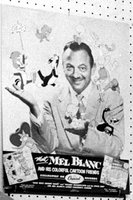 MEL BLANC ENTERS THE STUDIO
MEL BLANC ENTERS THE STUDIOOn April 21, 1949, Mel Blanc starts recording tracks for the Capitol Record Reader "Bugs Bunny In Storyland" and will finish the next day. The sessions are produced by Alan Livingston, with music by Billy May. The story is by Tedd Pierce and Warren Foster with illustrations for the attached booklet by Robert McKimson and Richard Thomas. Also on the record, but uncredited, were Arthur Q. Bryan (Elmer Fudd) and June Foray.
Jack Tatay maintains a great site about all the Capitol childrens records with Warner Brothers cartoon characters, with lots of images and sound clips.
Thursday, April 20, 2006
1908 - Lionel Hampton, vibes player with Benny Goodman and as a solo artist, is born in Louisville, KY.
1922 - Frank "Hylo" Brown, Jr., vocalist for Bradley Kincaid and his own bluegrass band The Timberliners, is born. Getting his nickname "Hylo" from his wide vocal range, Brown woulld go to be lead singer for Lester Flatt and Earl Scruggs and was inducted into the Grand Ol' Opry, the Kentucky Hall of Fame and is the 52nd member of the SPBGMA's Preservation Hall of Greats.
1948 - Craig Frost, Grand Funk Railroad keyboardist, is born in Flint, Michigan.
1952 - Pee Wee Hunt's "Oh!" becomes a million seller.
1953 - Miles Davis recorded the alternate take of "Enigma" at WOR Studios in NYC. Besides Miles on trumpet, also at the session were Art Blakey (Drums), Jimmy Heath (tenor saxophone), J.J. Johnson (trombone), Percy Heath (double bass), Gil Coggins (piano). The session was produced by Alfred Lion and Doug Hawkins was the recording engineer.
1960 - The Kingston Trio record "Bad Man's Blunder" which is the last single to feature the line up of Dave Guard, Nick Reynold and Bob Shane. This was the first time Dave Guard recorded playing the first 12 string guitar made by Gibson, which was custom built for him. It's also the day Guard's son Tommy was born.
1960 - Pianist Horace Parlan records 7 tracks, including the title song for his "Us Three" Blue Note album at Rudy Van Gelder's Englewood Cliffs, NJ studio along with George Tucker on bass and Al Harewood on drums.
1969 - The last original episode of The Beatles' King Features Syndicate cartoon show aired on ABC. Paul Frees voiced John and George and Lance Percival did Ringo and Paul.
Wednesday, April 19, 2006
 Dave Dexter, Johnny Mercer and Glenn Wallichs
Dave Dexter, Johnny Mercer and Glenn Wallichs
On April 19, 1990 Dave E. Dexter, Jr., publicist, A&R man, and producer for Capitol Records for more than 30 years, died.
During his time at Capitol, "Dex" was reponsible for signing and producing many of Capitol's early jazz and r&b artists including Julia Lee, Nellie Lutcher and Kay Starr, got Peggy Lee to come out of eary retirement in 1944 to record tracks for his "New American Jazz" album, put together the 4 album "History of Jazz" series in 1945 and its update in the '60s, was editor and writer of Capitol's promotional magazine "Capitol News", signed Duke Ellington and produced the "Satin Doll" track, became head of International A&R putting together the 400 albums in the "Capitol of the World" series of national and ethnic music, and remixed the early albums of "The Beatles" released in the U.S. which have been recenly released on CD for the first time.
"Dex" is also the narrrator on the commemorative promo albums for Capitol's 10th and 25th anniversaries.
His autobiography "Playback" has some great stories about Capitol's early history. He also wrote the books "Jazz Cavalcade" and "The Jazz Story" which is still considered a definitive history of Jazz up until the time of its publication in 1964.
Club Kaycee has a great site about Dave that includes photos and audio interviews. His papers and records are a special collection at the Miller Nichols Library at the University of Missouri Kansas City.
April 19, 1965 - "Ticket To Ride" is released as a single.
April 19, 1967 - The mono mix of "Sgt. Pepper's Lonely Hearts Club Band" is completed.
April 19, 1973 - The albums "1962-1966" (the "Red Album") and "1967-1970" (the "Blue Album") are released.
A free exhibition of "Unseen Beatles" images from the 1963-1966 "16 Magazine" archives is being held at American Royal Arts Gallery at 808A E. Las Olas Blvd., Ft. Lauderdale, FL until April 30, 2006. The exhibit also showcases images from Capitol Records and noted Beatles photographers Robert Freeman, Dezo Hoffman and Leslie Bryce.
Tuesday, April 18, 2006
Capitol Records Recording Department was started on April 18, 1945 with Bill Miller as boss. Miller would, 21 years later, "prepare for release" The Beatles "Yesterday ...And Today" and "Revolver" albums. He was also an A&R and Producer. He was responsible for signing and producing Jackie Davis and producing sessions for June Christy, Benny Goodman, The Four Freshmen, Sebastian Temple, Warren Durrett and even co-produced Ted Cassidy's novelty record "The Lurch". The current manager is Paula Salvatore, who has guided the always busy Capitol Studios since 2001. Check out Capitol Studios' website for more information. There's also a great article about the Capitol Studios on the studio expresso website.
Monday, April 17, 2006

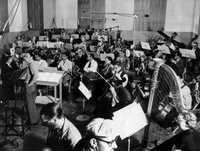
Vernise Elaine Pelzel emailed to identify her father, Vern Yocum, as the gentleman on the left in the foreground of the photo of the "Tone Poems of Color" session. To quote his biography on her website "Yocum is best known for the 17 year association with Nat King Cole and his thirty plus year collaboration with Frank Sinatra and Nelson Riddle. Yocum assisted trumpeter Cecil Reed in organizing The Musician's Guild in 1955, resulting in union reform." At the end of the biography Vernise has added a link to see the Vern Yocum Library Collection at the University of Arizona.
Vernise's site also has a biography of her uncle, Clark Yocum, who was a member of The Pied Pipers, Capitol Records' first star vocal group, best remembered for their cover of Johnny Mercer's "Dream" and for having the first album released by Capitol, "Songs by Johnny Mercer", released in 1944.
Sunday, April 16, 2006

55th ANNIVERSARY
Capitol Custom Division is formed on April 16, 1951.
This division of Capitol handled creating, producing, and distributing special promo records for outside companies and charities like Scripto, Uniroyal, Bacardi, 7-Up, Firestone, A&W Root Beer, Chevrolet, Dextol, March of Dimes, Renuzit, Salada Tea using tracks from Capitol's catalog as well as specially created material by Capitol artists. This type of product is currently handled by EMI-Capitol Special Markets.
Capitol Custom also produced demos and commercial records for independent artists like Cracker Jills, Help, Gert Benhana, Rafael Mendez, Harry Fields, The Legends, V. Attl, etc. as well as for church choirs and school bands.
Capitol Custom also handled creating promotional records for events like the 1962 Seattle World's Fair and even a single for John F. Kennedy's 1960 campaign featuring Frank Sinatra singing a reworded version of his hit "High Hopes".
Probably the most desired record created by Capitol Custom is the 7" single created as a limited pressing released on June 5, 1964 to promote the Beatles for Hollywood radio station KFWB and Wallichs' Music City that had an interview on side 1 and "You Can't Do That" on the flip side. Copies of this disc have been valued for as much as $2250 with the original mailer.
Most of the physical production was done out of the Capitol pressing plant in Scranton, PA.
There were branches of Capitol Custom in Canada, the U.K., and Australia.
Saturday, April 15, 2006
HAPPY BIRTHDAY TO THESE PAST AND PRESENT CAPITOL ARTISTS
 1933 - Roy Clark celebrates his 73rd birthday.
1933 - Roy Clark celebrates his 73rd birthday.1968 - Radiohead's Ed O’Brien celebrates his 38th birthday.
ALSO BORN THIS DAY
1909 - Vern Yocum, music preparer and copyist for Frank Sinatra, Nat "King" Cole, Peggy Lee, Keely Smith, Dean Martin, Ella Fitzgerald, Axel Stordahl, Gordon Jenkins, Billy May, Frank Duval and Nelson Riddle and many others. He also helped organize The Musician's Guild with trumpeter Cecil Reed in 1955.
REMEMBERING ROSE MADDOX
 Country Music legend, and Capitol Records artist, Rose Maddox died on April 15, 1998 in Ashland, OR.
Country Music legend, and Capitol Records artist, Rose Maddox died on April 15, 1998 in Ashland, OR.A touching remembrance and biography can be found at this Japanese web site.
Wednesday, April 12, 2006
HAPPY 20TH WEDDING ANNIVERSARY (HOPEFULLY)
Jennifer Lerner, stepdaughter of Bozo creator and past president of Capitol Records Alan Livingston, and daughter of Broadway lyricist and producer Alan Jay Lerner and actress Nancy Olson, married Carlyle Fraser II on April 12, 1986.
The wedding notice can be found on the NY Times website.
Tuesday, April 11, 2006
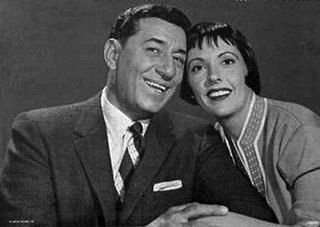

Today is the 50th Anniversary of Louis Prima and Keely Smith signing with Capitol Records.
I had the unexpected joy of meeting Keely late one night in at The Tower. I was heading down the hall towards the parking lot on my home and she was coming out of the hallway from the studios. I recognized her at once and was just blown away. I mean, who could imagine bumping into Keely Smith at the Tower in 1999? Overcoming my tounge-tied shyness when meeting legends, I introduced myself, told her what a pleasure it was to meet her, and asked what brought her back to Capitol. She said she was working on a new album which turned out to be "Swing, Swing, Swing" released by Concord in 2000. She was very gracious and seemed tickled that someone, besides those working in the studios, recognized her and appreciated the signifigance of her return.
AND IN MORE RECENT NEWS
Today is also the 36th anniversary of The Beatles' "Let It Be" single hitting #1 on the Billboard Charts in 1970.
Monday, April 10, 2006
I've pulled the rest of my collection of Capitol related photos out of storage and found these two uncredited images of Frank Sinatra and his studio orchestra recording "Tone Poems of Color" on February 22, 1956 in Studio B. Any help in identifying anyone else in the photos will, of course be much appreciated! Clicking on the photos will bring up larger images to make identification easier.
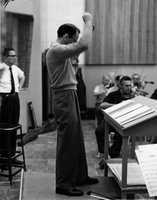
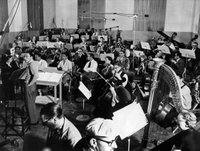
Sunday, April 09, 2006
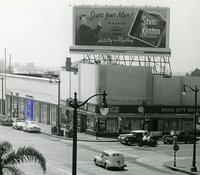 Capitol's 1st office at 1483 Vine Street, Hollywood, CA. The entry is highlighted in blue. Detail from a photo by Otto Rothschild.
Capitol's 1st office at 1483 Vine Street, Hollywood, CA. The entry is highlighted in blue. Detail from a photo by Otto Rothschild. Capitol's 2nd office at 1507 Vine Street, Hollywood, CA. The offices took up the entire 2nd floor above Glenn Wallichs' Music City. Detail from a photo by Gene Lester.
Capitol's 2nd office at 1507 Vine Street, Hollywood, CA. The offices took up the entire 2nd floor above Glenn Wallichs' Music City. Detail from a photo by Gene Lester.
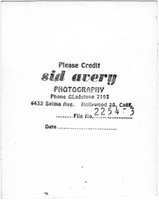
Here's a rarity. This is the back of Music City from a proof by Sid Avery from the estate of Fred Rice, Capitol's National Merchandising Development Manager, who was with the company from 1946-1973.For those interested, there's also the back of the photo with Avery's contact info stamp.
 I recreated the neon sign with help from a few photos and the cover of Capitol's 1946 catalog. I'd appreciate it if anyone can advise me of the true colors used. I uploaded it as an animated .gif file but it doesn't seem very animated. It was working when I viewed it on its own before uploading to the blog. Any help on what to do would be appreciated.
I recreated the neon sign with help from a few photos and the cover of Capitol's 1946 catalog. I'd appreciate it if anyone can advise me of the true colors used. I uploaded it as an animated .gif file but it doesn't seem very animated. It was working when I viewed it on its own before uploading to the blog. Any help on what to do would be appreciated.
 On April 9, 1956, Gene Vincent and the Blue Caps record the demo of "Be-Bop-A-Lula" in the studios at radio station WCMS in Nashville, TN. Also recorded are demos of "Race With The Devil" and "I Sure Miss You". Sherrif Tex Davis sends the demos are sent to Capitol's A&R man, and producer, Ken Nelson who will arrange a recording session at Owen Bradley's Nashville studio for May 4th, 1956 that will produce the released single version of "Be-Bop-A-Lula".
On April 9, 1956, Gene Vincent and the Blue Caps record the demo of "Be-Bop-A-Lula" in the studios at radio station WCMS in Nashville, TN. Also recorded are demos of "Race With The Devil" and "I Sure Miss You". Sherrif Tex Davis sends the demos are sent to Capitol's A&R man, and producer, Ken Nelson who will arrange a recording session at Owen Bradley's Nashville studio for May 4th, 1956 that will produce the released single version of "Be-Bop-A-Lula".
Thursday, April 06, 2006
I got a copy of this invite emailed to the Tower Staff from a few people at Capitol today.
"Today we have a very special occasion to celebrate at the Tower.
On this day 50 years ago, the Capitol Tower opened its doors.
For the past 50 years, Capitol Records has conducted business in the Tower and we have seen some of the greatest recording artists of the last century come through our doors.
For those of you who love the Tower and the music it has represented over the past 50 years, please join us at 2:00 p.m. for cake in the Gogerty courtyard.
One of our former employees put together a Web site with the history of the Tower. http://popculturefanboy.blogspot.com."
I'm glad I was able to get some people fed! :) Hopefully, someone who was there will send me a photo (HINT! HINT!).
Ironically, I was outside the Tower at about 1:30 in between job interviews.
There was a security guard in front. I asked if they still had pamphlets about the tower for tourists. He said they stopped doing that after 9-11. I was working at the Tower when there was a bomb scare that evacuated the building right after 9-11 so I could understand. He was posted outside the doors going to the lobby, so it looks like tourists can't come in to look at the Gold Records anymore. I told him about the anniversary and showed him the exact spot where Wallichs and Morse stood to light the beacon. I then noticed that inlaid into the floor outside the entry to the lobby where the words "THE CAPITOL TOWER", so maybe I should go back and edit a few things to use the correct name. "Ouch" The things I forget.
This was the first time I had been back on the sidewalks around the Tower since 2001 so it was interesting to see how the addition connecting the Tower to the Gogerty Building finished up. One nice thing is that where Buddy DeSylva's star is on the Hollywood Walk of Fame used to be the exit of the parking lot. Now, with the addition there, at least his star isn't getting run over all the time. A nice touch on the addition is that the lighting fixtures along the outside of the Tower that can be seen in some of the opening day photos were reproduced for the exterior of the addition. The Gogerty Building exterior looks great, although I miss the old restaurant that was along the Yucca side. I was able to walk through the building before it was gutted with Capitol's then creative director Tommy Steele and it was in pretty sad shape. The upper floor that at one time was Fred Astaire's dance studio and later was Hollywood Rainbow Color Separators, was being squatted in with no running water. And, more irony here, a chrome proof of a job that I had designed for Delicious Vinyl was laying on the floor in pretty clean shape amidst all the filth.
Along with visiting the Tower, I also had time to stop by a few of Capitol's former homes. Where the door leading up to Capitol's first office just south of Sunset and Vine was is now the down ramp into the parking lot of the Bank of America next to the Arclight Cinemas. Next stop was to the former location of Wallichs' Music City. The ground floor where the store was is now a Borders with a rounded front that echoes the front of Music City in the '40s and '50s. Walking through the store it was nice to see rows of music and books where the old record bins were. The back of the store goes out to what used to be the alleyway of the Tropics restaurant and later one of the homes of Tom Breneman's "Breakfast in Hollywood" radio show. Later Tom moved up the street into the former Hollywood Recreation Center, Bowling Alley, TAV Building, etc. They kept the facade of the front of the building and there's now a "Schwab's" neon sign were there used to be the ABC Broadcasting sign that you see in th old postcards. It doesn't look like the new Schwab's in open any longer as it's windows were papered over. The main entrance of the building is now called the Presidential Entrance leading to the lobby of the new condos of the site. I whistled the tune of "My Bonnie" in front of it as that used to be Breneman's theme.
I walked back a bit south on Vine to what used to be the entrance to the lobby of Capitol's 2nd home. It's now an EA Games shop. Walking in, the size of the space is about the same as photos I have of the lobby. I imagined the staircase to the right that led up to the offices, lined with the photos of Capitol's artists. I told the guy behind the counter about what used to be where his shop is and said he hadn't heard that before.
I then walked back up north on Vine to catch my bus, passing what used to be Clara Bow's It Cafe. It's now the Original Coney Island cafe and shop. Looking across the street, Bernard's Luggage and the Hollywood Import House are still there, but for who knows how long. Last I heard everything from the south east corner of Hollywood and Vine down to Selma and over to Argyle, except for the Taft Building is going to be demolished for retail and condo space. Looking down, I noticed Jo Stafford's star on the Walk of Fame is right across the street from the parking lot that used to be the Brown Derby. The Derby was where Stafford's husband, Paul Weston, along with Lloyd Dunn, Jim Conklin, Sonny Burke, Jesse Kaye, Henri Rene and Dennis Faron met on May 28, 1957 to form the National Academy of Recording Arts & Sciences. There's another 50th anniversary waiting to be blogged, hee, hee. The Broadway Building is still under renovation to also be turned into condos. The Broadway Building used to house Capitol's Transcription Service and a few other departments. It also used to have a neon sign attached to its corner that read "Hollywood and Vine" that can be seen in some old postcards along with a few Capitol publicity photos that were used in Capitol's 50th Anniversary book for 1992 and on there old hollywoodandvine.com website. Kitty corner to the Broadway, the Equitable building is also being turned into condos called "The Lofts at Hollywood & Vine". The Hollywood and Vine restaurant is still there and now, where Tips used to be, is the Vine Street Lounge which looks like it might have outdoor seating in the alley next to The Forbidden City restaurant next door.
Heading for the bus stop, I noticed that the exIncendo restaurant is now closed up and workers are inside doing something to the space. The little Mexican grill that was at the north east corner of the Equitable is gone, meaning all that's left of it is the concrete slab foundation. Workers were busy gutting the floors above the H&V restaurant, whose menu was too expensive for me, and a new advertising mural is being painted on the side of the building. I had a great $2.25 hot dog at Ronnie's Donuts in the Pantages building. The service from the woman behind the counter was great. We got talking and she's worried because all the condo construction is hurting business. I told her that the people who'll be living in the condos gotta eat somewhere which she found a lot funnier than I thought it was.
The bus came and headed west on Hollywood Blvd., past the new Virgin Store which I passed earlier in the day when Mayor Johnny Grant was out getting ready to unveil Rocky Horror Picture Show producer Lou Adler's star on the Walk of Fame. Unfortunately because of the traffic, I didn't have time to stop or I'd miss my first interview, but it was great seeing his honor after all his help.
Thursday April 6, 2006 is the official 50th anniversary of the grand opening of the Capitol Records Tower at 1750 Vine Street, Hollywood, CA
 Click the above image to get a larger version. This image, from Hollywood's honorary Mayor Johnny Grant, shows Capitol co-founder, and at that time president, Glenn Wallichs and Samuel Morse's grandaughter, Leila Morse, with an unknown gentleman throwing the switch to light the beacon on top of the tower to spell out H-O-L-L-Y-W-O-O-D in Morse code for the first time! If you can identify the 2nd gentleman, please leave a comment.
Click the above image to get a larger version. This image, from Hollywood's honorary Mayor Johnny Grant, shows Capitol co-founder, and at that time president, Glenn Wallichs and Samuel Morse's grandaughter, Leila Morse, with an unknown gentleman throwing the switch to light the beacon on top of the tower to spell out H-O-L-L-Y-W-O-O-D in Morse code for the first time! If you can identify the 2nd gentleman, please leave a comment.
Wednesday, April 05, 2006
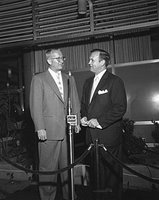 Paul Weston and Johnny. Weston, bandleader, arranger and husband of Jo Stafford, was Capitol's first music director and was also one of the founders of the Grammys. He, and his orchestra, can be heard on almost all of Capitol's early hits, either on their own or behind many of Capitol's greatest singers.
Paul Weston and Johnny. Weston, bandleader, arranger and husband of Jo Stafford, was Capitol's first music director and was also one of the founders of the Grammys. He, and his orchestra, can be heard on almost all of Capitol's early hits, either on their own or behind many of Capitol's greatest singers.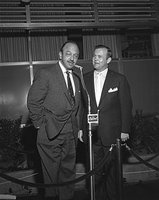 Mel Blanc and Johnny. Blanc was a recording artist for Capitol, doing both comedy records and recreating his Looney Tunes voices for many of Capitol's children's records.
Mel Blanc and Johnny. Blanc was a recording artist for Capitol, doing both comedy records and recreating his Looney Tunes voices for many of Capitol's children's records. Nelson Riddle with Johnny. Riddle was a master arranger and composer and was also a top-selling recording artist for Capitol.
Nelson Riddle with Johnny. Riddle was a master arranger and composer and was also a top-selling recording artist for Capitol.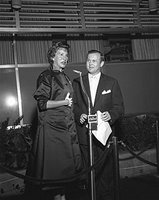 Patty Andrews with Johnny. One of the famous Andrew Sisters who recorded solo for Capitol as well as with her sisters when they reunited also in 1956.
Patty Andrews with Johnny. One of the famous Andrew Sisters who recorded solo for Capitol as well as with her sisters when they reunited also in 1956.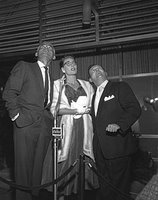 Actor Jeff Chandler, his wife and Johnny all looking up at something happening up above.
Actor Jeff Chandler, his wife and Johnny all looking up at something happening up above.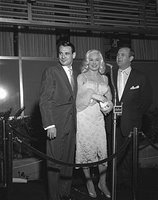 Ray Anthony, then wife Mamie Van Doren with Johnny. Big band leader Ray Anthony would record the first big band album in the Tower's studios adding to his many hit Capitol recordings.
Ray Anthony, then wife Mamie Van Doren with Johnny. Big band leader Ray Anthony would record the first big band album in the Tower's studios adding to his many hit Capitol recordings.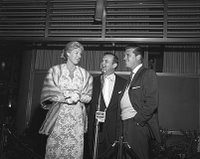 Sheila MacRae, Johnny, and Gordon MacRae. Sheila would go on to be the 3rd Alice in the Honeymooners. Gordon would be on Capitol's first Gold Album "Oklahoma!" and was one of Capitol's hit recording artists with his series of records from famous musicals and operettas.
Sheila MacRae, Johnny, and Gordon MacRae. Sheila would go on to be the 3rd Alice in the Honeymooners. Gordon would be on Capitol's first Gold Album "Oklahoma!" and was one of Capitol's hit recording artists with his series of records from famous musicals and operettas.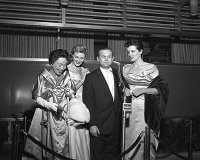 Connie Haines, Beryl Davis, Johnny and Jane Russell. Haines sang with both the Tommy Dorsey and Harry James bands. Davis sang with the Glenn Miller, Benny Goodman and Les Brown Bands. Russell also sang ("Button and Bows" in "Paleface", etc.) but is best know as an actress in movies like "The Outlaw", "Gentlemen Prefer Blondes", and many more. The three would later perform as a trio on Ed Sullivan's "Toast of the Town"
Connie Haines, Beryl Davis, Johnny and Jane Russell. Haines sang with both the Tommy Dorsey and Harry James bands. Davis sang with the Glenn Miller, Benny Goodman and Les Brown Bands. Russell also sang ("Button and Bows" in "Paleface", etc.) but is best know as an actress in movies like "The Outlaw", "Gentlemen Prefer Blondes", and many more. The three would later perform as a trio on Ed Sullivan's "Toast of the Town"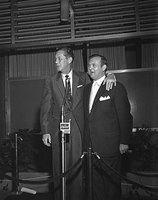 Peter Potter and Johnny. Potter was a Hollywood DJ who also emceed the early TV panel show "Jukebox Jury"
Peter Potter and Johnny. Potter was a Hollywood DJ who also emceed the early TV panel show "Jukebox Jury"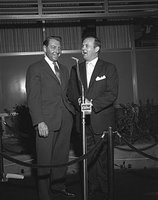 David Rose with Johnny. Rose is best known for composing and recording "Holiday on Strings" and "The Stripper".
David Rose with Johnny. Rose is best known for composing and recording "Holiday on Strings" and "The Stripper". Bill Welsh with Johnny. Welsh was a president of the Hollywood Chamber of Commerce and a sports and special events announcer on L.A.'s KTTV where he broadcast 48 consecutive Rose Bowl Parades.
Bill Welsh with Johnny. Welsh was a president of the Hollywood Chamber of Commerce and a sports and special events announcer on L.A.'s KTTV where he broadcast 48 consecutive Rose Bowl Parades. Stan Chambers, Glenn Wallichs, and L.J. Brown, who was identified (many thanks) but I can't find any more info on Mr. Brown.
Stan Chambers, Glenn Wallichs, and L.J. Brown, who was identified (many thanks) but I can't find any more info on Mr. Brown. Stan Chambers with Lou Busch. Busch was a recording artist that led the revival of ragtime in the '50s under the name Joe "Fingers" Carr, he was also a Capitol A&R executive, studio pianist for Peggy Lee, Tennessee Ernie Ford and Jo Stafford. He was also husband to one of Capitol's first female stars, Margaret Whiting. Many thanks to the anonymous tipster for the ID.
Stan Chambers with Lou Busch. Busch was a recording artist that led the revival of ragtime in the '50s under the name Joe "Fingers" Carr, he was also a Capitol A&R executive, studio pianist for Peggy Lee, Tennessee Ernie Ford and Jo Stafford. He was also husband to one of Capitol's first female stars, Margaret Whiting. Many thanks to the anonymous tipster for the ID. 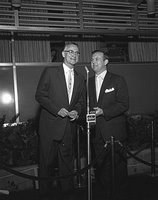 Unknown gentleman with Johnny. Possibly "Pinto" Colvig, the voice of Bozo on Capitol's children's records and the voice of Goofy for Walt Disney cartoons. Please help identify him.
Unknown gentleman with Johnny. Possibly "Pinto" Colvig, the voice of Bozo on Capitol's children's records and the voice of Goofy for Walt Disney cartoons. Please help identify him.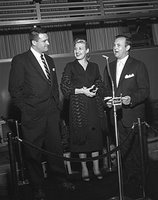 An unknown gentleman, Marilyn Maxwell and Johnny. Mayor Grant thinks the woman is actress and singer Marilyn Maxwell but isn't positive. Please help identify both her and the gentleman.
An unknown gentleman, Marilyn Maxwell and Johnny. Mayor Grant thinks the woman is actress and singer Marilyn Maxwell but isn't positive. Please help identify both her and the gentleman.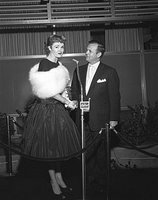 Unknown woman with Johnny. Please help identify her.
Unknown woman with Johnny. Please help identify her.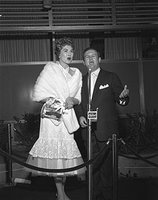 Another unknown with Johnny. Please help identify.
Another unknown with Johnny. Please help identify.
 Image courtesy of Nori J. Muster from a 1956 souvenir program of the Hollywood Jr. Chamber of Commerce Sprint Car Races featuring the Disc Jockey Derby
Image courtesy of Nori J. Muster from a 1956 souvenir program of the Hollywood Jr. Chamber of Commerce Sprint Car Races featuring the Disc Jockey DerbyI was the red carpet announcer for the many fans gathered standing on Vine Street at the official opening. I interviewed the stars and executives of Capitol.
I was with KMPC at the time but Capitol asked me to host. My job was to get the stars in. All of Capitol's stars were there.
Stan Chambers was also there. He was doing a show that went all over L.A. called "City at Night".
The opening was held over 3 or 4 days as people would come in to town. They would hold sessions in the studios that I'd also report on.
There were a lot of standout moments.
Frank Sinatra was there. I went to a few of his recording sessions which were the most cherished invitations in town. He liked to record on Sunset at Universal Recorders which was across the street from what's now the Spaghetti Factory. He liked the sound of that studio.
Nat "King" Cole was there as were Ray Anthony and Mamie Van Doren and Shelia and Gordon MacRae. Also there were Stan Kenton, Nelson Riddle, Kay Starr, Beryl Davis, Connie Haines, Jane Russell, and many others.
Capitol founders Johnny Mercer and Glenn Wallichs were there. Glenn was a quiet man and a very nice person. His brother Clyde, who operated Music City at Sunset and Vine, was the showman. Glenn started the first car radio shop in Hollywod. He may have invented, and certainly improved on, the car radio.
Ann Rutherford, who acted as one of the sisters in "Gone with the Wind" was there. At Ted Turner's Walk of Fame cermony, she said "I once owned the Tower". That probably was when she was married to Dave May [of the May Company -ed] and she got the land in the divorce.
Also in attendance that I remember were Capitol execs Dave Dexter, Jr. [producer and then head of Capitol's publicity dept. -ed] and Lloyd Dunn [then VP of advertising and marketing at Capitol and one of the founders of the Grammys -ed].
Tuesday, April 04, 2006
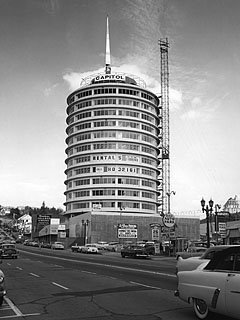
This image was taken after the ground level that contains the lobby and the recording studios was finished, but the top level and spire are still under construction and the protective louvres have yet to be installed.
The large gray wall was painted white with first an oval Capitol logo, and then the "bulls-eye" Capitol logo, in the upper left corner, both of which lit up at night. In 1990, the 26'x88' mural "Hollywood Jazz: 1945-1972" by Richard Wyatt was unveiled with portraits of Chet Baker, Gerry Mulligan, Charlie Parker, Tito Puente, Miles Davis, Ella Fitzgerald, Nat King Cole, Shelly Manne, Dizzy Gillespie, Billie Holiday, and Duke Ellington. The acrylic on concrete mural is currently in a very faded and peeling state.
Tapping on the image goes to a large (660k) .jpg that shows a lot more detail about the building and the surrounding neighborhood including the Hollywood Tower Hotel, Nick's Place Burgers, and the parking lot for Dupars, Tips, Ontra and Hody's restaurants The parking lot is still there.
The Hollywood Tower Hotel is still there in all it's glory.
Dupar's is now The Forbidden City night club and restaurant.
Nick's shack and the "Burger" sign are still there but it looks like it's been turned into storage space for The Forbidden City. Nick's was a great place to get an inexpensive burger during lunch time if you didn't get eat at Rosa's shop on the 2nd floor of the Tower.
Tips Steak House, after being the location of the Collector's Bookstore until the Equitable Building was retro-fitted in 2000, was the back room of the Hollywood and Vine restaurant, but is currently the Vine Street Lounge. The Ontra Cafeteria was demolished after the 1994 earthquake and is now a parking lot next to the Palace Theatre.
One part of Hody's is now a Blood Spot tattoo and piercing parlor and the rest is currently the Basque night club. For a great history of this building, with photos, go to this article on LottaLivin.com.
Also visible in this image is a sign on the side of the Gogerty Building for the Westlake College of Music which was converted to additional office space for Capitol Records and EMI in 2002.
The photo also shows the phone number to call for renting office space in the Tower as well as construction signs showing credits for Welton Becket & Associates and C.L. Peck construction. I wonder if the realtor will use that phone number if the builing gets sold to the condo developer who put in an offer to EMI for the Tower?
• The Tower was Hollywood’s first air-conditioned high-rise office building.
• The circular floors of the building are approximately 92 feet in diameter.
• The gross area is 93,000 square feet.
• The Tower is 150 feet tall
• The second floor has a diameter of only 78 feet to give the rest of the Tower the appearance of "floating.”
• The 82 foot trilon spire atop the Tower is just for looks except during the holiday season, when it supports the strands of lights that turn the top of the Tower into an award-winning giant Christmas tree display.
• The Tower is 13 stories tall because that was the height limit in Los Angeles at the time for commercial buildings. Wallichs had wanted to build higher, and it was the one sour note of the construction experience for him when, the year after the Tower was completed, the ordinance was changed.
• There are 72 windows on each floor and the Tower's distinctive porcelain enameled louvres protect the glass area from excessive heat and glare of the sun.
An article in the June, 1956 issue of Record and Sound Retailing listed “as a service to Capitol and a warning to gagsters” the following good-natured jokes that had already been heard too many times:
“It’s round like a record, but are they going to do when if the industry changes to tape?”
“There are no squares in the Capitol Tower.”
“You ought to put a coin machine in front of the building so tourists can drop in fifty cents and watch the Tower revolve.”
“Secretaries are going to love the new building because their bosses can’t corner them there!”
“I hear they’re changing the speeds on the Freeway lanes behind the Capitol Tower to 78, 45, and 33 1/3 MPH!”
Song Publisher’s Lament: “I went to Capitol and they gave me the run-around.”
“We hear there’s a huge record changer on the roof that ejects floors.”
“Now that the intersection of Hollywood and Vine has the ultra-modern Capitol Tower, the name’s being changed to Hollywood and Vinyl.”
“After they put an Italian restaurant on the roof, they’re going to call the building the Tower of Pizza”
Through the contributions of all of Capitol Records’ artists and employees, the Capitol Tower remains a symbol of exciting growth and progress and honors the memories of those who turned a dynamic little record company into one of the world’s leaders in the field of recorded entertainment.
THE CAPITOL TOWER’S CONSTRUCTION TEAM WAS:
Materials and Suppliers
Architects: Louis Naidorf for Welton Becket & Associates
Building Contractor: C. L. Peck
Leasing Agent: Hubert Boisvert & Co.
Project Architect: John B. Fish (Welton Becket & Associates)
Project Manager: Harold B. Rightmire (C. L. Peck)
General Superintendent: A. B. Standard (C. L. Peck)
Job Superintendent: William H. Murphy (C. L. Peck)
Resident Engineer: Ted Niederhofer
Decor And Color Consultant: Robert Morris (Altman-Morris Interiors, Beverly Hills)
Sub-Contractors
Acoustical Treatment: Sound Control Company
Aluminum Mullions: Hodge Sheet Metal
Aluminum Windows: W. P. Fuller & Company
Asphaltic Concrete: Goode & Schroeder
Carpeting: Rite-Loom Carpet Company
Concrete: Transit Mixed Concrete
Concrete "Pozzolith": The Master Builders Company
Construction Tower: Steel Form Contracting Company
Draperies: Nelson Draperies
Electrical Signs: Triple "A" Neon
Electrical Work: Seeger Electric Co.
Elevators & Dumbwaiter: Otis Elevator Company
Equipment Lift: Coast Elevator Company
Finish Hardware: Union Hardware Company
Fire Doors: United Cork Companies
Insulation (Cork): Wand Corporation
Lathing & Plastering: Martin Brothers
Mail Chute & Box: Frank Peck Specialty Company
Metal Decking: Metal Fabricators
Metal Doors & Frames: Overly Manufacturing Company
Millwork: Los Angeles Millwork Company
Miscellaneous Metal: Savino Iron Works
Painting: J. P. Carroll Company
Plantings: D. E. Millery & Company
Plumbing & Heating: State Plumbing & Heating Company
Porcelain Enamel: Porcelain Veneer, Incorporated
Pyro Doors & Pyro Frames: Durand Metal Door Company
Reinforcing Steel: Truscon Steel Company
Resilient Type Floors: Degen & Brody
Rolling Door: Lawrence Steel Company
Roofing: Riness Roof Company
Sheet Metal & Louvers: Paller & Goldstien
Structural Steel: Apex Steel Corporation, Limited
Tile Work: Selectile Company, Incorporated
Ventilating & Air Conditioning: Western Air & Refrigeration
Vertical Blinds: Vertical Blind Corporation of America
Weatherstripping: Weatherstrip Specialties
Wire Fencing: Los Angeles Fencing Company
Wood Partitions: Weber Showcase & Fixture
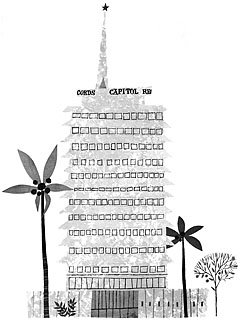
Monday, April 03, 2006
Capitol Records was founded in 1942 by singer/ songwriter Johnny Mercer, electronics inventor/music store owner Glenn Wallichs, and songwriter/Broadway and motion picture producer/and then Production Head of Paramount Pictures B.G. “Buddy” DeSylva.
Capitol Records officially opened for business on June 4, 1942 in a small 15’x50’ second floor office at 1483 Vine Street, just south of Sunset Boulevard (currently the entrance to the Bank of America parking structure), above Sy Devore’s Tailor Shop. The organization would become the first major record company to have its world headquarters in Hollywood, emphasizing the close relationship between the music industry and motion pictures, radio and, eventually, television.
Realizing the importance of radio and magazines in building consumer interest and demand, co-founder Glenn Wallichs opened a new era in record promotion by making Capitol Records the first company to give disc jockeys and reviewers complimentary advance copies of product prior to release to stores. Wallichs would even hand-deliver the first copies of Capitol’s releases to some of Hollywood’s local disc jockeys.
On July 1, 1942, the label released its first nine 78rpm singles, which included “I Found A New Baby” by Paul Whiteman and His Orchestra (The first act singed, and the first song recorded, by Capitol Records), Freddie Slack’s “Cow Cow Boogie” (Capitol Records’ first big hit) with vocals by 17-year-old Ella Mae Morse, and “Strip Polka” by co-founder Johnny Mercer (the first time he had sung and recorded one of his own songs for commercial release with the added bonus of guest vocals by comedian Phil Silvers).
In 1944 the company released its first album entitled SONGS BY JOHNNY MERCER by the Pied Pipers. 1944 was also the year that Capitol Records’ Dave Dexter, Jr. was able to lure Peggy Lee out of retirement to begin recording for the label starting with the all-star multi-artist album New American Jazz produced by Dexter.
1945 was another year of firsts for Capitol Records with The King Cole Trio’s self-titled album becoming the labels first number one album and Johnny Mercer’s “On The Atchison, Topeka and the Santa Fe” becoming the label’s first number one single.
On March 2, 1946, Betty Hutton would be come the first solo female Capitol Artist to hit number 1 on Billboard’s Hot 100 Chart with “Doctor, Lawyer, Indian Chief” Also in 1946 Capitol Records would move into bigger and better offices at 1507 Vine Street on the second floor the building that also housed Wallichs’ Music City on the north west corner of Sunset and Vine (soon to be a new apartment and shopping complex). It would be the year that Capitol got its first number 1 country hit with recently signed Merle Travis’ “Divorce Me C.O.D.”, release its first Broadway Cast Album, Johnny Mercer’s “St. Louis Woman”, and become one of the top 4 record companies in the U.S. In September of 1946 Capitol issued a recording that would affect generations of children - the first Bozo the Clown disc - BOZO AT THE CIRCUS. Created, written and produced by then vice-president of the new children’s division, Alan W. Livingston, the record contained another first, the Record Reader, which allowed children to read along, turning the pages when given an audio cue. The success of this record, and the many millions of other “Bozo Approved” children’s records and licensed products that were to be sold, made Capitol Records the leader in that market for the following decade.
1947 brought Nat “King” Cole’s first solo recording “Nature Boy.”
In 1949, the label began producing 45 and 33 rpm discs becoming the first record company to release its product in all three speeds. Also that year, Capitol opened its own recording studios at 5515 Melrose Avenue (the current home of television station KCAL-9) in Hollywood and became the first record company to record on magnetic tape. Also in 1949, in order to support the new forms of R&B, Country and especially Jazz music, Capitol signed and recorded many new artists including Miles Davis, who recorded the tracks that would become the seminal album THE BIRTH OF THE COOL in Capitol’s New York Studios.
The ‘40s would also see releases by such popular artists as Dennis Day, Martha Tilton, Connie Haines, Bobby Sherwood, Gordon Jenkins and His Orchestra, Stan Kenton, Jo Stafford, Margaret Whiting, Benny Carter, Andy Russell, Billy Butterfield, Jerry Colonna, Betty Hutton, Johnny Johnston, Paul Weston, Sam Donahue and His Orchestra, Skitch Henderson, Alvino Rey and His Orchestra, Clark Dennis, Hal Derwin, The Dinning Sisters, Red Ingle and The Natural Seven, Freddie Martin, Jack Smith, Jan Garber, Nellie Lutcher, Julia Lee, Blu Lu Barker, Gordon MacRae, The Sportsmen, Mel Blanc, Jimmy Wakely, Cliffie Stone, Art Van Damme, Tennessee Ernie Ford, Kay Starr, Sammy Davis Jr., Dean Martin, Jerry Lewis, Mel Torme, Mickey Katz and Yogi Yorgesson
1951 would bring Capitol Records first million selling single, “Smoke, Smoke, Smoke That Cigarette” by Tex Williams as well as the first multi-track recoding to reach number 1 on the pop charts, Les Paul and Mary Ford’s “How High The Moon”
By August of 1952, Nat “King” Cole and The King Cole Trio are responsible for sales of 15 million records.
In January of 1953 Jackie Gleason released his debut Capitol Records album MUSIC FOR LOVERS ONLY, which would spend 17 weeks at number 1 and stay on the album charts for more than 2 years. Frank Sinatra was signed to Capitol by Alan W. Livingston and had his first session at Capitol's studios at 5515 Melrose Avenue on April 2. On October 10 Stan Freberg’s “St. George and The Dragonet” became Capitol’s first comedy record to reach number 1 on the pop charts.
On January 15 1955, a majority interest in Capitol was purchased by Electric Musical Industries (EMI) of Great Britain (their west coast offices are located on the top floor of The Tower).
February 22, 1956 sees the first recording session in the new Capitol Studios built as part of The Capitol Tower at 1750 Vine Street which officially opens on April 6. 1956 also sees Capitol records first step into Rock ‘n’ Roll with A&R executive Ken Nelson signing Gene Vincent and His Blue Caps and producing the studio version of their soon to be top 10 hit “Be Bop A Lula.”
On January 2, 1957 Capitol acquires classical label Angel Records which makes it first release in August 1958.
On July 8, 1958 - Capitol is awarded the Recording Industry In America’s first ever gold album for the Motion Picture Soundtrack to “Oklahoma!” and Laurie London’s single “He’s Got The Whole World (In His Hands)" receives one of the first gold singles. 1958 also sees Capitol releasing its first stereo album and Capitol’s biggest folk hit with The Kingston Trio’s “Tom Dooley” going number 1 on November 17 and will be awarded one of the first Grammy Awards in May of 1959.
The ‘50s would also see releases by such popular artists as Benny Goodman, Harry James, Yma Sumac, Les Baxter, William “Hopalong Cassidy” Boyd, Ray Anthony, Joe “Fingers” Carr, Pee Wee Hunt, Nelson Riddle, Hank Thompson, Jane Froman, Faron Young, John Standley, Billy May, Clyde McCoy, Sonny James, Walter Schumann, The Four Knights, The Five Keys, Jean Shepard, Ferlin Husky, The Andrew Sisters, June Christy, The Four Freshmen, “Deacon” Andy Griffith, Bing Crosby, Grace Kelly, Louis Armstrong, Don Robertson, Tommy Sands, The Four Preps, Robert Preston, Jonah Jones, Dakota Stanton, The Johnny Otis Show, Laurindo Almeida, Robert Wagner and The Robert Wagner Chorale, Keely Smith and Louis Prima, and Frank Pourcel.
On April 28, 1961, Judy Garland’s bravura performance at Carnagie Hall was rushed released and “Judy At Carnagie Hall” spends 13 weeks at number 1 on the album charts and goes on to win 4 Grammy Awards.
In the Spring of 1962, 21 year old A&R man Nick Venet signs The Beach Boys with their debut single “Surfin’ Sufari coming out in August. July sees the signing of Bobby Darin. Also signed that year are Nancy Wilson and Glen Campbell.
1963 sees Capitol signs Wayne Newton early in the year and The Beatles in November.
April 4, 1964 and The Beatles hold the entire top 5 spots on Billboard’s Hot 100 simultaneously, a record that has yet to be beaten.
April 1966 and Capitol Records releases its first 8 track, Judy Garland’s “Judy At Carnagie Hall”.
August 26, 1967 sees Bobbie Gentry’s “Ode To Billie Joe” become the first solo female Capitol artist to have number 1 song on the Billboard Hot 100 chart since Kay Starr’s “Wheel Of Fortune” went number 1 on March 15, 1952.
August 3, 1968 sees the release of Capitol Records first cassette tape “Sounds of the Great Bands”.
The ‘60s would see other popular artists coming out on Capitol Records such as the Lettermen, Lou Rawls, Al Martino, Kyu Sakamoto, Barbra Streisand, Buck Owens, Peter & Gordon, Merle Haggard, Cannonball Adderly, Earle Doud and Alen Robin, The Seekers, The Outsiders, Bobbie Gentry, The Stone Poneys (featuring vocalist Linda Ronstadt), The Steve Miller Band, Quicksilver Messenger Service, The Band, Fred Neil, Mary Hopkin, Joe South, The Bob Seger System, Human Beinz, and Jimi Hendrix.
1970 would see Anne Murray signed to Capitol and her becoming the first Canadian female artist to have both her album “Snowbird” and her single “Snowbird” receive Gold records. Also in 1971 Linda Rondstadt will start her solo career. April 17, 1970 would see Paul McCartney's first solo album released, with a press release announcing his leaving The Beatles, ending the band. Lennon, McCartney, Harrison and Starr go on to stellar solo careers in this decade.
August 1, 1971 would see the first superstar Rock ‘N’ Roll benefit show when George Harrison puts on “The Concert For Bangladesh”.
December 9, 1972 would see Helen Reddy’s “I Am Woman” become Capitol’s first non-Beatle number 1 on Billboard’s Hot 100 chart since Bobbie Gentry’s “Ode To Billie Joe" hit #1 on August 29, 1967.
1973 sees the release of Pink Floyd’s album DARK SIDE OF THE MOON which will go to sell over 15 million copies and stay on the Billboard Album Charts for over 10 years.
May 15, 1976 will see the Sylvers “Boogie Fever” become Capitol’s first R&B act to hit number 1 on Billboard’s Hot 100 chart
The ‘70s would see releases from such popular artists as: Grand Funk Railroad, Bloodrock, Pink Floyd, Badfinger, The Pipkins, Joy Of Cooking, Paul McCartney and Wings, John Lennon and The Plastic Ono Band, Freddie Hart, Leo Kottke, Raspberries, Edward Bear, Skylark, Hurricane Smith, Andy Kim, Dr. Hook, Little River Band, Natalie Cole, Sweet, Tavares, Steve Miller Band, Maze featuring Frankie Beverly, Bob Welch, A Taste Of Honey, Peabo Bryson, Sun, The Motels, The Knack and April Wine
1982 would see the creation, with Capitol Records-EMI Canada, of the XDR tape technology that would expand the dynamic range of cassette tapes.
On August 14, 1984 Capitol Records releases its first CD - Pink Floyd’s DARK SIDE OF THE MOON. Also in 1984, Blue Note Records president Bruce Lundvall is brought in to launch the Manhattan label based in New York which will eventually be incorporated into the EMI America label.
The release in 1987 of The Beatles catalog on CD lead thousands into electronics stores to buy their first CD players.
In late 1989 Capitol Nashville would become Liberty Records under president Jimmy Bowen and becomes the first country division of one of the major labels in Nashville to be independent from its corporate offices in terms of signing, business affairs, international, sales, promotion , finance and production. Also in 1989 would be the launch of Capitol’s acclaimed Collectors’ Series which would mine the company’s vaults for both the original master recordings of hits and unreleased gems from the great artists that are part of Capitol’s history and include authoritative liner notes and complete annotation of the tracks.
The ‘80s would see releases from such popular artists as: Bob Seger & The Silver Bullet Band, Neil Diamond, Delbert McClinton, Billy Squier, Duran Duran, Anne Murray, Juice Newton, The Tubes, Iron Maiden, Little River Band, George Clinton, Thomas Dolby, Missing Persons, The Motels, Peabo Bryson, Joe Cocker, Tina Turner, Ashford & Simpson, Queen, Freddie Jackson, Arcadia, Power Station, Katrina & The Waves, Poison, Tanya Tucker, Billy Vera & The Beaters, Sly Fox, The Doobie Brothers, Martha Davis, Great White, Crowded House, M.C. Hammer, Megadeth, Richard Thompson, The Beastie Boys, BeBe and Cece Winans, Sheriff, Garth Brooks, Donny Osmond, Ann Wilson & Robin Zander.
1990 would see M.C. Hammer’s “Please Hammer, Don’t Hurt ‘Em” become the first Rap album to spawn 3 top 10 singles.
1992 would see a massive celebration of Capitol Records’ 50th anniversary.
Capitol Records enters cyberspace in 1994 with the start of its internet site hollywoodandvine.com.
Released in 1998, Radiohead’s MEETING PEOPLE IS EASY was Capitol Records’ first Home Video on DVD.
The ‘90s would see releases from such popular artists as: Bonnie Raitt, Eric Johnson, The Whispers, Mellow Man Ace, The Cover Girls, Richard Marx, Young MC, Tracie Spencer, Tommy Henriksen, Everclear, Block, Sonichrome, Liz Phair, Cocteau Twins, Butthole Surfers, Mazzy Star, Des’ree, Radiohead, Kendall Payne, Meredith Brooks, Bran Van 3000, Marcy Playground, Spearhead, Foo Fighters, The Moffatts, Second Coming, The Jon Spencer Blues Explosion, Robbie Robertson, Robbie Williams, Push Stars and the Kottonmouth Kings.
Capitol Records enters the new millennium with releases by Bosson, Dilated Peoples, Moist, Vega, Sunday, Tara MacLean, Shivaree, Sammie, Dandy Warhols, Rachelle Ferrell, Pru, Dexter Freebish, Amy Corriea, Auf Der Maur, Coldplay, Idlewild, Cole, Splashdown, Methrone, Shannon McNally, Stir, Matthew Jay, OTEP, Sparklehorse, and Dave Navarro.
Now more than half way through the first decade of a new century, the hits keep on coming with releases by Ak'sent, Ambulent, Roseanne Cash, Cherish, Chingy, Faith Evans, Fischerspooner, Hurt, Javier, Letoya, Shelby Lynn, The Magic Numbers, Morningwood, OK Go, The Redwalls, Relient K, Reeve Oliver, Saosin, Shout Out Louds, Annie Stella, Skye Sweetnam, The F-Ups, Van Hunt, The Vines and Yellowcard.
Standing on what was formerly farm land and then a parking lot, the Capitol Tower is one of Hollywood’s most famous and identifiable landmarks. The structure can be spotted from miles away on the busy Los Angeles freeways – and even the skies are made aware of its presence, thanks to the red beacon light on top of the building that has blinked out H-O-L-L-Y-W-O-O-D in Morse code since the Tower was officially opened on April 6, 1956, except, starting in June 1992 and lasting for one year, the beacon flashed "C-A-P-I-T-O-L-5-0" to celebrate the company's 50th anniversary. Vacationers from all over the world visit the Capitol Tower each year to view the unique design and admire the Platinum® and Gold® records that adorn the building’s lobby.
Ground breaking for the Capitol Tower took place on September 27, 1954. Set to cost a then astronomical $2 million to construct, press releases at the time noted that this structure would be unlike any other – it would be the world’s first round office building.
The man responsible for this innovative circular design was architect Welton Becket, who had already become internationally renowned for his advanced and unorthodox creations including Los Angeles’ Prudential building and the Cairo Hilton, and would go on to help design the Los Angeles International Airport’s space-age inspired Theme Restaurant.
All though the sturdiest rumor about the building is that it was designed to look like a stack of records with a needle on top, this is not true. Beckett explained his design as providing “economy of construction, operation, and maintenance, plus maximum utilization of space.”
The master-of-ceremonies for the Tower’s groundbreaking was the announcer and cast member of the Jack Benny Show, Don Wilson, who would later become the narrator of many of Capitol's children’s records. Among those present were Capitol’s then President and chairman of the board (and one Capitol’s three co-founders) Glenn Wallichs and his family, song-writer Johnny Mercer (another of Capitol’s co-founders), and Mrs. Buddy DeSylva (who's husband was the third of Capitol's founders and the company’s first president).
Also attending the ceremonies were Mel Blanc, Les Baxter, as well as other Capitol recording artists, members of the Hollywood Chamber of Commerce and Los Angeles City Council, and many, many interested fans. Afterwards, the Hollywood Chamber of Commerce and the Hollywood Ad Club held a testimonial lunch banquet at the Hollywood Roosevelt Hotel honoring, and roasting, Wallichs. Attendees included emcee Dean Martin, as well as Paul Weston, Sammy Cahn, Tennessee Ernie Ford, and many local disc jockeys who helped narrate Capitol's history of hits up until that time.
Though completion was originally scheduled for October of 1955, the Capitol Tower enjoyed its official grand opening on April 6, 1956. The ceremonies were conducted with great Hollywood flair which included a multitude of celebrities, a dozen swirling searchlights, and bleachers erected to let fans watch all the excitement. The highlight of the evening came when Samuel Morse’s granddaughter, Leila, pulled the switch that lit the spire’s beacon for the first time. Attendees included EMI’s chairman of the board Sir Joseph Lockwood, many of Capitol Records’ recording artists including Gordon MacRae and his wife Shelia, future Mayor of Hollywood Johnny Grant, then KTLA reporter Stan Chambers, Ava Gardner, Pattie Andrews of the Andrews Sisters, and many other of Hollywood’s elite.
The Capitol Tower’s first nickname was “Glenn’s Silo,” referring to Glenn Wallichs’ Nebraska farm upbringing. It would also be known both as “The House That Nat Built” and “The House That Bozo Built” due to the vast amounts of records and merchandise both had sold for the company.
The Tower became an immediate Hollywood landmark, a "must-see" for tourists.
On July 23, 1987, Los Angeles Mayor Tom Bradley proclaimed it “Capitol Tower Day,” characterizing the building as “one of Los Angeles’ most distinguishable landmarks” which has become “almost as recognizable as the Hollywood sign itself.”
Through the contributions of all of Capitol Records’ artists and employees, the Capitol Tower remains a symbol of exciting growth and progress and honors the memories of those who turned a dynamic little record company into one of the world’s leaders in the field of recorded entertainment.
Capitol Tower Facts and Figures:
• The Tower was Hollywood’s first air-conditioned high-rise office building.
• The Tower has 13 stories and is 150 feet tall.
• The circular floors of the building are approximately 90 feet in diameter.
• The second floor has a diameter of only 78 feet to give the rest of the Tower the appearance of “floating.”
• There are 72 windows on each floor and the Tower's distinctive porcelain enameled louvres protect the glass area from excessive heat and glare of the sun.
• The 82 foot trilon spire atop the Tower is just for looks except during the holiday season, when it supports the strands of lights that turn the top of the Tower into an award-winning giant Christmas tree display.
The Gold and Platinum records hanging in the lobby and throughout the Tower were awarded to Capitol Records by the Recording Industry Association of America (RIAA) in recognition of best-selling recordings.
Capitol Records received its first Gold discs in 1958, the year the RIAA instituted the awards. The label’s first gold single was presented for Laurie London’s “He’s Got The Whole World (In His Hands).” Capitol’s (and the RIAA’s) first Gold album was for the soundtrack to the movie musical OKLAHOMA, starring Gordon MacRae and Shirley Jones, and hangs behind the guard station, on the right-hand wall, in the lower right corner.
The requirements for a Gold album is a minimum of 500,000 units and $1 million in sales. The RIAA instituted its Platinum award in 1975 (honoring 1 million units sold) and its Multi-Platinum award (multiple millions sold) in 1984. On March 16, 1999, the RIAA launched the Diamond Awards, honoring sales of 10 million copies or more of an album or single.
In total, Capitol Records’ artists have received awards for sales of more than 21 Diamond, 253 Multi-Platinum, 272 Platinum and 587 Gold albums, singles and videos.
The Beatles are the label’s biggest winners, receiving 14 Diamond, 37 Multi-Platinum, 40 Platinum, and 52 Gold certifications for sales of albums and singles. Each former member of the Fab Four also recorded as a solo act for Capitol Records after the band’s break-up, garnering even more “precious metal.”
Among Capitol’s other legendary recording artists, for certification of sales of albums and singles: The Beach Boys’ recordings for Capitol have produced 6 Multi-Platinum, 9 Platinum and 21 Gold awards; Frank Sinatra’s have garnered 2 Multi-Platinum, 5 Platinum and 16 Gold awards; and Nat “King” Cole’s have earned 5 Platinum and 8 Gold awards.
Garth Brooks is the biggest award-winner of Capitol Records’ current artists, with 7 Diamond, 32 Multi-Platinum, 9 Platinum, and 10 Gold awards for sales of albums, singles and videos.
On February 22, 1956, almost 9 weeks before the Tower’s grand opening, the Capitol Studios were used for the first time when Frank Sinatra led a 56-piece orchestra on a series of instrumental compositions written by Nelson Riddle that would become the album "Tone Poems of Color".
One of the most innovative features of the new building was its studios – the three studios which occupy the Tower’s base were the first ever built for high-fidelity recordings. Each studio was designed to “float” on a layer of asphalt-impregnated cork, providing insulation from external vibration. Zig-Zag wall panels and movable reflecting surfaces – birchwood on one side (for hard sound) and Fiberglass on the other (for a soft sound) – were installed to provide complete and variable acoustic control.
The studios were made further unique by the construction of special shock-mounted reverberation chambers–commonly called echo chambers – which were buried 25 feet below the parking lot behind the Tower. In these chambers sound technicians can, with complete naturalness, create any degree or quality of "room tone" desired in recording. The chambers still exist and are constantly in demand for their striking aural qualities.
Dimensions of the three studios were as follows: Studio A – 57,000 cubic feet (62 feet long by 46 feet wide by 20 feet high), Studio B – 47,000 cubic feet (62 feet long by 38 feet wide by 20 feet high), and Studio C – 6,200 cubic feet (26 feet long by 15 feet wide by 16 feet high).
Over the years the Capitol Studios have hosted recording projects for such Capitol superstars as Frank Sinatra, Nat “King” Cole, Judy Garland, Miles Davis, Peggy Lee, Ella Fitzgerald, Gene Vincent and The Blue Caps, Grand Funk Railroad, The Raspberries, Hammer, Prince, Crowded House, as well as such distinguished outside artists as Louis Armstrong, Billie Holiday, Dwight Yoakam, Bruce Hornsby & The Range, Julio Iglesias, Wilson Phillips, Barbra Streisand, Oingo Boingo, and Whitney Houston.
With over 45 years of experience, today’s Capitol Studios have evolved into the studios of the future. Respecting the technology and creativity of the past and cultivating an adventurous spirit into the future, Capitol Studios have retained their status as leaders in digital and global sound technology.
Sunday, April 02, 2006
1935
July - As a gift from his wife Ginger, Johnny Mercer, then under contract to Paramount Studios, has an auto radio installed at one of the four Wallichs’ Radio Shops and meets Glenn Wallichs for the first time.
1938
Glenn Wallichs merges his fifth shop with Al Jarvis’ Stomp Shop (Al Jarvis is Los Angeles’ first disc jockey and was heard on KFWB) to start Hollywood House of Music which devoted half of its space to a commercial recording studio. Wallichs first met Jarvis while working as a technician at KFWB and learned about pop music and its makers from him. Specializing in custom recording, Wallichs created all of his own equipment, including turntables, and recorded weddings, parties and air checks of radio shows. Jarvis’ KFWB show “Make Believe Ballroom” was broadcast from the store. This is where Wallichs first met Stan Kenton. Wallichs actually performs on one record, a.k.a. “The World's Worst Record,” which was recorded in the shop with Kenton, Paul Weston and Jo Stafford (on drums) using the aliases The Katzenjammers with Stu Becker, Frankenstein Mark, Bunny Donnen, and Tony Schroeder. Jarvis holds onto the record for 16 years as blackmail (joke) and presents the record to Glenn at The Los Angeles Ad Club lunch honoring Glenn on groundbreaking day for the Capitol Records Tower, September 27, 1954.
1940
July - On an insufferably hot night, 29 year old Glenn Everett Wallichs holds an unshuttering ceremony which opens Wallichs’ Music City at the north west corner of Sunset and Vine (1501 N. Vine Street), Hollywood, CA with The King Cole Trio performing. This leased space will be the first in a chain of stores in the Los Angeles area. Well-wishers included Spike Jones, Decca Records’ Jack Kapp, Freddie Slack, Skinny Ennis and fast-rising young personal manager Carlos Gastel, who had driven 3000 miles from New York with Dave Dexter, Jr. to meet “a hell of guy with a hell of a future.” The popularity of the store, as well as its close proximity to the motion picture and national radio network studios, lets Wallichs become the close pal and confidant of Hollywood’s most renowned singers, musicians and picture studio and radio luminaries.
1941
Fall/Winter - Fed up with having to get his records from franchised dealers, Glenn Wallichs suggest to Johnny Mercer the idea of starting their own record company. Mercer, tired of hearing his songs poorly recorded, agrees.
1942
February 2 - It's a Monday and Johnny Mercer arranges a lunch attended by himself, Glenn Wallichs, and Buddy DeSylva, head of production at Paramount Studios, at Lucey’s Club Restaurant at 5444 Melrose Avenue in Hollywood, California to discuss Paramount financing the new label. DeSylva tells them Paramount isn't interested but he agrees to personally put up an initial $10,000 and will later put in another $15,000, though Wallichs and Mercer will only use $15,000 of the initial investment.
February 7 - The check clears and Liberty Records is born.
March 27 - Papers are signed by George G. DeSylva, John Mercer, and Glenn E. Wallichs before Los Angeles County and California state Notary Public Leta Miccum to acknowledge that they have executed articles of incorporation for Liberty Records, Inc.
April 6 - Liberty Records holds its first recording session which features Martha Tilton, Johnny Mercer, The Mellowaires, Gordon Jenkins and His Orchestra, Phil Silvers, Hubert "Bumps" Myers, and Jimmy Van Heusen.
April 9 - Liberty Records, Inc. incorporation papers are officially filed in California. Its first quarters are in “The Chateau” on De Longpre Avenue in Hollywood, California.
May 21 - From 3:00 to 5:50 pm, Johnny Mercer is in the booth at C.P. MacGregor’s Recording Studios as Freddie Slack & His Orchestra, along with 17 year old vocalist Ella Mae Morse, record “Cow-Cow Boogie” in a split session with David Street.
Sometime in May - Unable to get approval to use the name from Liberty Music Shops in NYC, Mrs. Ginger Mercer (Johnny’s wife), at a dinner at Chasen's Restaurant, suggests Capitol Records. Glenn Wallichs comes up with the idea of the four stars above the Capitol dome logo.
June 4 - Glenn Wallichs decides, for the first time in the history of the American music industry, to give promotional copies of releases to disc jockeys and reviewers for free and starts by personally giving a pre-release copy of "Cow-Cow Boogie" to disc jockey Peter Potter, creator of “The Juke Box Jury” radio show in Hollywood, California. This concept quickly makes Capitol Records a favorite of disc jockeys across the country and forces the rest of the industry for the first (and by no means the last) time to follow Capitol. "Cow-Cow Boogie will quickly become Capitol’s first big seller, soon to be followed by Johnny Mercer’s “Strip-Polka” and Bobby Sherwood’s “Elk’s Parade".
Also, Capitol Records officially starts in rented office space at 1483 Vine Street, Hollywood, California (now the Bank of America building). It’s 15 feet wide and about 50 feet long, with no air-conditioning, and would be the company’s home until moving above Wallichs’ Music City in 1946.
Along with the founders, among the first employees were sales manager (later vice president) Floyd Bittaker, Dave Shelly in charge of artists, Auriel MacFie (the company's first female employee) who operated the small switchboard and was also the company's receptionist and typist, and former Down Beat Magazine and Billboard Magazine columnist, songwriter and producer Dave Dexter, Jr., who joins Capitol Records as publicity, pubic relations and advertising chief as well as writing for Capitol News and doing a&r and producing chores for various Jazz and R&B artists on Capitol. He will later head the Capitol of the World division and select which acts Capitol would release from EMI’s offerings, in the process rejecting The Beatles twice.
Offices were also quickly opened in NYC at Modern Music Sales Company, one of Capitol Records’ first distributors, at 629 Tenth Avenue.
June 5 - Sessions with Paul Whiteman and His Orchesstra are held at C.P. MacGregor’s Recording Studios at 729 S. Western Ave. in Hollywood, California which will yield the recordings used for Capitol's first single release, "I Found A New Baby" and "The General Jumped At Dawn" (Capitol 101). Almost all of Capitol’s early recording sessions were held there.
June 29 - Capitol Records officially releases its first six 78 RPM singles in Hollywood, California according to an article in the July 4, 1942 issue of The Billboard magazine.
They singles released are:
101. A Side “I Found A New Baby” - Paul Whiteman and his Orchestra: Buddy Weed at Piano
B Side “The General Jumped At Dawn” - Paul Whiteman and his Orchestra
102. A Side “Cow-Cow Boogie” - vocal Ella Mae Morse
B Side “Here You Are” - Freddie Slack and his Orchestra
103. A Side “Strip-Polka” - vocal Johnny Mercer
B Side “The Air-Minded Executive” - vocal Johnny Mercer
104. A Side “Johnny Doughboy Found A Rose In Ireland” - vocal Dennis Day
B Side “Phil, The Fluters Ball” - vocal Dennis Day
105. A Side “The Angels Cried” - vocal Martha Tilton and The Mellowaires
B Side “I’ll Remember April” - vocal Martha Tilton with Gordon Jenkins and his Orchestra
106. A Side “He Wears A Pair Of Silver Wings” - vocal Connie Haines
B Side “I'm Always Chasing Rainbows” - Gordon Jenkins and his Orchestra
July 13 - Capitol Records releases three more singles:
107. A Side “Elk’s Parade”
B Side “I Don’t Know Why” - Bobby Sherwood and his Orchestra
108. A Side “Serenade In Blue” - vocal Martha Tilton with Paul Whiteman and his Orchestra
B Side “I’ve Got A Gal In Kalamazoo” - Paul Whiteman and his Orchestra - vocal The Mellowaires
109. A Side “Windmill Under The Stars”
B Side “Conchita Lopez” - Johnnie Johnston
The first nine releases are listed in the July 11, 1942 issue of The Billboard magazine in an ad placed by Modern Music Sales Company.
July 15 - “New Capitol Records Splended” was the headline of Capitol Records’ first review in Down Beat Magazine by Mike Levin.
July 30 - The American Federation of Musicians’ “Petrillo Ban” starts, banning all new recordings by musicians, effectively starting the end of big bands and the rise of the solo artist and vocal groups, who are are able to record either a cappella or with simple accompaniment
Also in 1942: Johnny Mercer, Tex Ritter, Martha Tilton, Margaret Whiting, Ella Mae Morse, Freddie Slack and Johnnie Johnston are among the first artists signed to Capitol Records - Paul Weston becomes musical director of Capitol Records, will eventually marry Jo Stafford and become the first president of National Association of Recording Arts and Sciences (N.A.R.A.S.) - Sales of the first 25 singles released totaled $195,000
Top 10 Singles
Johnny Mercer “Strip Polka”
Freddie Slack & His Orchestra “Cow Cow Boogie”
Freddie Slack & His Orchestra “Mr. Five By Five”
Bobby Sherwood “Elk’s Parade”
1943
March 1943 - “Capitol News” started. It includes background and tour info on artists as well as the latest in trends and upcoming releases.
October 9, 1943 - A.F.M. President James Petrillo lifts record ban for Capitol Records and Decca Records. It will be another year before Columbia Records and RCA/Victor Records come to terms with the A.F.M. A fund for unemployed musicians is established.
November - “All For You” by The King Cole Trio is Capitol Records’ 39th 78rpm single release and goes top 10 on pop charts
November - Stan Kenton records his first Capitol Records session which produces “Artistry In Rhythm”
November 30 - The King Cole Trio have their first Capitol Records recording session which produces “Straighten Up And Fly Right”
Also in 1943: Capitol Records starts Trans-Continental Music, first music publisher on the west coast - Chicago Distribution office on 1809 Indiana Avenue opens - Dave Dexter, Jr. and Glenn Wallichs go on a master recording “hunt” for releases during recording ban and get Bob Sherman’s “Lovely Hannah,” Cecille Burke’s “From Twilight ‘Til Dawn,” and The King Cole Trio’s “Vim, Vom, Veddle” and “All For You” - Andy Russell, Jo Stafford, Pied Pipers, Benny Carter and Paul Weston are signed to Capitol Records - Sales reach $750,000
Top 10 Singles
The King Cole Trio “All For You”
Stan Kenton “Eager Beaver”
Johnny Mercer “G.I. Jive”
Ella Mae Morse “Shoo-Shoo Baby”
Freddie Slack & His Orchestra “That Old Black Magic”
Margaret Whiting “My Ideal”
1944
March - Capitol Records signs production deal with Scranton Record Company with an option to buy for $2 million
May - Capitol Records first 78rpm album, “Songs by Johnny Mercer,” is released
September 21, 1944 - Capitol Records Distribution Company is formed.
Also in 1944: James B. Conkling joins Capitol Records, will become V.P. then will go on to Columbia Records as president
First children’s record “Puss in Boots” released - Dave Dexter, Jr. produces compilation “New American Jazz,” Capitol Records third 78rpm album release, which brings Peggy Lee out of retirement as part of an all-star ensemble - Betty Hutton, Peggy Lee and The Dinning Sisters are signed to Capitol Records - Benny Carter’s “I’m Lost” is number 1 on the R& B charts - Sales reach $2,250,000
Top 10 Singles
Benny Carter “Hurry, Hurry”
The King Cole Trio “Straighten Up And Fly Right” - reaches number 9 in April
Stan Kenton & His Orchestra “Do Nothin’ Till You Hear From Me”
Stan Kenton & His Orchestra “And Her Tears Flowed Like Wine”
Stan Kenton & His Orchestra “How Many Hearts Have You Broken?”
Johnny Mercer “Accentuate The Positive”
Ella Mae Morse “No Love, No Nothin’”
Ella Mae Morse “Milkman, Keep Those Bottles Quiet”
Ella Mae Morse “The Patty Cake Man”
The Pied Pipers’ “Mairzy Doats”
The Pied Pipers’ “The Trolley Song”
Andy Russell “Besame Mucho”
Andy Russell “Amor”
Andy Russell “I Dream Of You”
Jo Stafford “I Love You”
Jo Stafford “It Could Happen To You”
Martha Tilton “I’ll Walk Alone”
1945
April 18 - Capitol Records Recording Department is established with Bill Miller as boss.
Also in 1945: Buddy DeSylva suffers severe heart attack - Dave Dexter, Jr.’s 4 volume series of 78rpm albums, “History of Jazz,” is released - Plans for Capitol Records’ first Los Angeles Plant are set - “Johnny Mercer’s Record Shop,” a nightly radio show, debuts on NBC with regular guests Paul Weston and Jo Stafford - Coleman Hawkins is signed to Capitol Records - Sales reach $6,392,000
Number 1 Albums
The King Cole Trio “The King Cole Trio” - Capitol Records’ first Number 1 album
Freddie Slack “Boogie Woogie”
Number 1 Singles on Billboard’s Hot 100 Chart:
July 28 - Johnny Mercer “On the Atchison, Topeka and Sante Fe” - Capitol Records’ first number one single - stays on top for seven weeks and wins an Academy Award for Best Song
Top 10 Albums
Billy Butterfield “Gershwin”
The Dinning Sisters “The Dinning Sisters”
St. Luke’s Choristers “Christmas Carols”
Paul Weston “Music For Dreaming”
Top 10 Singles
Billy Butterfield & His Orchestra “There Goes That Song Again”
Jerry Colonna “Bell Bottom Trousers”
Betty Hutton “Stuff Like That There”
Johnny Johnston “(All Of A Sudden) My Heart Sings”
Johnny Johnston “Laura”
Johnny Johnston “There Must Be A Way”
Stan Kenton & His Orchestra “Tampico”
Stan Kenton & His Orchestra “It’s Been A Long, Long Time”
Peggy Lee “Waitin’ For The Train To Come In”
Johnny Mercer with Jo Stafford and The Pied Pipers “Candy” - listed as a number 1 single in 50th Anniversary book but wasn’t
The Pied Pipers “Dream” - listed as a number 1 single in 50th Anniversary book but wasn’t
Andy Russell “I Can’t Begin To Tell You”
Jo Stafford “There’s No You”
Jo Stafford “Out Of This World”
Jo Stafford “That’s For Me”
Jo Stafford “Symphony”
Martha Tilton “I Should Care”
Martha Tilton “Stranger In Town”
Paul Weston & His Orchestra “It Might As Well Be Spring”
1946
April - Capitol Records issues first stock; 95,000 shares with the founders holding on to 70%. 1500 new stock holders on record
June - Bob Hope releases “I Never Left Home” - a collection of shows performed at various armed forces camps
September - Bozo the Clown, a creation of new Childrens Records VP Alan Livingstion, is introduced with the 78rpm album “Bozo at the Circus” along with another Livingston creation, the Record Reader album, which allow listeners to read along with the record, giving them sound cues to turn the page. The album goes on to sell 100,000 copies in its first month
Also in 1946: Scranton Record Company & Distribution Center purchased for $2 million - Capitol Records ranks among the top 4 record companies in the United States - Capitol Records’ first Los Angeles plant is opened - Capitol Records releases its first Orignal Broadway Cast Album “St. Louis Woman” - Capitol Records home office moves to 1507 N. Vine Street, the north west corner of Sunset and Vine, in space above Wallich’s Music City - The King Cole Trio records “The Christmas Song,” which peaks at number 3 on the pop charts, as well as “Route 66” and “(I Love You) For Sentimental Reasons” - Merle Travis’ “Divorce Me C.O.D.” is the number 1 country single for 14 weeks - Alvino Rey, Merle Travis, Julia Lee, Sam Donahue and Jack Smith are signed to Capitol Records - Fred Rice joins Capitol Records as an art director and designs the inital look of Bozo. He will go on to become director of the display arts department and eventually manager of national merchandising development by the time he leaves Capitol Records in 1974 - Sales reach $12,885,857
Number 1 Albums
The King Cole Trio “King Cole Trio - Volume 2”
Number 1 Singles on Billboard’s Hot 100 Chart:
March 2 - Betty Hutton “Doctor, Lawyer, Indian Chief” hits number one for a week
March 9 - Johnny Mercer “Personality” knocks Betty Hutton out of the top spot - stays on top for a week
Top 10 Albums
Stan Kenton “Artistry in Rhythm”
Top 10 Singles
Billy Butterfield & His Orchestra “Rumors Are Flying”
The King Cole Trio “You Call It Maddness”
The King Cole Trio “The Christmas Song” peaks at number 3
Sam Donahue & His Orchestra “Dinah”
Sam Donahue & His Orchestra “Just The Other Day”
Sam Donahue & His Orchestra “Put That Kiss Back Where You Found It”
Sam Donahue & His Orchestra “A Rainy Night In Rio”
Skitch Henderson & His Orchestra “Five Minutes More”
Stan Kenton & His Orchestra “Shoo-Fly Pie And Apple Pan Dowdie”
Peggy Lee “I Don’t Know Enough About You”
Peggy Lee “It’s A Good Day”
Peggy Lee “It’s All Over Now”
Johnny Mercer “Zip-A-Dee-Doo-Dah”
Johnny Mercer “My Sugar Is So Refined”
Johnny Mercer “A Gal In Calico”
The Pied Pipers “In The Moon Mist”
Alvino Rey & His Orchestra “Cement Mixer (Put-ti Put-ti)” - His first single for Capitol Records - goes top 5
Andy Russell “Laughing On The Outside (Crying On The Inside)”
Andy Russell “They Say It’s Wonderful”
Andy Russell “Pretending”
Freddie Slack & His Orchestra with Ella Mae Morse “The House Of Blue Lights”
Jo Stafford “Day By Day”
Jo Stafford “The Things We Did Last Summer”
Jo Stafford “White Christmas”
Paul Weston & His Orchestra “Ole Buttermilk Sky”
Margaret Whiting “Guilty”
Margaret Whiting “Oh, But I Do”
1947
March - Capitol Records opens International Division
August - Nat King Cole records “Nature Boy,” his first solo recording
Winter - Julia Lee’s “King Size Papa” goes number 1 on the R&B chart for 21 weeks and cracks top 15 on pop charts
Also in 1947: Buddy DeSylva resigns, Johnny Mercer resigns, Glenn Wallichs elected to Chairman of the Board/President - Jo Stafford with Red Ingle & The Natural Seven’s “Temptation (Tim-tayshun)” hits number 1 on the country charts - Merle Travis’ “So Round, So Firm, So Fully Packed” is the number 1 country single for 14 weeks - Benny Goodman, Les Paul and Hank Thompson are signed to Capitol Records - Sales reach $14, 510, 206
Number 1 Singles on Billboard’s Hot 100 Chart:
February 15 - The King Cole Trio “(I Love You) For Sentimental Reasons” -stays for one week
August 9 - Tex Williams and his Western Caravan “Smoke!, Smoke!, Smoke! (That Cigarette)” on the Capitol Americana label - stays for 6 weeks. It will be number 1 on the country charts for 16 weeks and go on to sell over 2 million copies.
Top 10 Singles
Clark Dennis “Peg O’ My Heart”
Hal Derwin “The Old Lamplighter”
The Dinning Sisters “My Adobe Hacienda”
Sam Donahue & His Orchestra “My Melencholy Baby”
Sam Donahue & His Orchestra “I Never New”
Sam Donahue & His Orchestra “Red Wing”
Sam Donahue & His Orchestra “The Whistler”
Betty Hutton “I Wish I Didn’t Love You So”
Red Ingle & The Natural Seven with Jo Stafford “Temptation (Tim-tayshun)” - listed as a number 1 single in the 50th anniversary book but wasn’t
Peggy Lee “Chi-Baba, Chi-Baba (My Bambino Go To Sleep)”
Freddie Martin “Lady From 29 Palms”
Johnny Mercer “Winter Wonderland”
Johnny Mercer “Huggin’ And A-Chalkin’”
Johnny Mercer “Sugar Blues”
The Pied Pipers “Open The Door, Richard”
The Pied Pipers “Mam’selle”
Alvino Rey & His Orchestra “Near You”
Andy Russell “Anniversary Song”
Jack Smith “Civiization (Bongo, Bongo, Bongo)
Jo Stafford “Sonata”
Jo Stafford “Feudin’ And Fightin’”
Jo Stafford “Serenade Of The Bells”
Martha Tilton “How Are Things In Glocca Mora?”
Martha Tilton “That’s My Desire”
Martha Tilton “I Wonder, I Wonder, I Wonder”
Paul Weston & His Orchestra “Linda”
Paul Weston and Matt Dennis’ “Ole Buttermilk Sky”
Margaret Whiting “You Do”
Margaret Whiting “Pass That Peace Pipe”
1948
March 28 - Nat “King” Cole marries Maria Ellington
Also in 1948: Capitol Records issues first stock dividend - Capitol Records signs distribution agreements with Mexico and Germany - Capitol Records signs 3 year deal with Decca Records, Ltd. of London for UK distribution - Capitol Records becomes first company to use magnetic tape during recording session - American Federation of Musicians imposes another recording ban that lasts for most of the year - Hank Thompson’s first single for Capitol Records, “Humpty Dumpty Heart,” is a smash on country chart -Nellie Lutcher’s brother Joe Lutcher’s “Shuffle Woogie” is an R&B top 10 hit - Blu Lu Barker, Scatman Crothers and Mel Blanc are signed to Capitol Records - Sales reach $18,000,000 on 405 singles and 44 albums
Number 1 Albums
The King Cole Trio “King Cole Trio - Volume 3”
Stan Kenton “A Presentation Of Progressive Jazz”
Number 1 Singles on Billboard’s Hot 100 Chart:
March 13 - Peggy Lee “Manana” - stays for 9 weeks
May 15 - Nat King Cole “Nature Boy” knocks Peggy Lee out of the top spot - stays for seven weeks
August 28 - Pee Wee Hunt “Twelfth Street Rag” - stays for 8 weeks and will become the biggest hit of Capitol Records’ first 10 years.
October 9 - Margaret Whiting “A Tree in the Meadow” knocks Pee Wee Hunt out of the top spot - stays for two weeks
Top 10 Albums
Jan Gerber “College Medleys”
Peggy Lee “Rendezvous With Peggy Lee”
Nellie Lutcher “Nellie Lutcher”
Top 10 Singles
Blu Lu Barker “A Little Bird Told Me” - Capitol Records’ first R& B artist to get into the top 10 of the pop charts
The Dinning Sisters “Button And Bows”
Benny Goodman & His Orchestra “On A Slow Boat To China”
Peggy Lee “Golden Earrings”
Gordon MacRae “It’s Magic”
Gordon MacRae “Hair Of Gold, Eyes Of Blue”
The Pied Pipers “My Happiness”
Alvino Rey & His Orchestra “I’m Looking Over A Four-Leaf Clover”
The Sportsmen “You Can’t Be True Dear”
The Sportsmen with Mel Blanc “Woody Woodpecker Song” - spends 5 weeks at number 2 during the summer
Jo Stafford “Serenade Of The Bells”
Jo Stafford and Gordon MacRae “Say Something Sweet To Your Sweetheart”
Jo Stafford and Gordon MacRae “My Darling, My Darling” - check to see if it was number one
Jimmy Wakely “One Has My Name (The Other Has My Heart)”
Margaret Whiting “Now Is The Hour (Maori Farewell Song)”
Margaret Whiting “Far Away Places”
1949
January 10, 1949 - Capitol Records moves its recording from C.P. MacGregor’s to facilities at 5515 Melrose Avenue, Hollywood. Completely remodeled, the studio makes all recordings on tape
March - Nat “King” Cole records Billy Strayhorn’s “Lush Life”
June - Capitol Records of Canada Ltd. is incorporated. All shares are bought by Lockwood Miller, a business man from London, Ontario - originally from Los Angeles
Also in 1949: The A.F.M.’s recording ban ends - Capitol Records acquires the Telefunken Records classical library - Capitol Records releases first classical album as part of the Capitol Classics series - Capitol Records begins manufacturing phonographs, needles and accessories - Capitol Records becomes first record company to release in three speeds (78, 45 and 33 rpm) - Sugar Chile Robinson is signed and becomes America’s youngest recording star - Buddy DeSylva paints a scene of the first meeting with Glenn Wallichs and Johnny Mercer at Lucey’s Club Restaurant - Margaret Whiting and Jimmy Wakely’s “Slippin’ Around” goes to number 1 on the country charts - Les Paul and Mary Ford are married with 4-year-old Steve Miller’s father, a Dallas doctor, as best man. Paul becomes Miller’s first hero in the music business - Les Baxter’s “Music Out Of The Moon” is Capitol Records’ first 4 color seperation album cover - Miles Davis begins recording the 12 tracks that will eventually become "The Birth Of The Cool" after 8 of the tracks are released in 1954 on a 10" in the "Classics In Jazz" series - Ray Anthony and Tennessee Ernie Ford are signed to Capitol Records
Top 10 Albums
The King Cole Trio “King Cole Trio - Volume 4”
Jan Garber “More College Medleys”
Stan Kenton “Stan Kenton Encores”
Jo Stafford and Gordon MacRae “Kiss Me Kate”
Cliffie Stone “Square Dances”
Art Van Damme “Cocktail Capers”
Paul Weston “Songs Without Words”
Margaret Whiting/Gordon MacRae/Peggy Lee “South Pacific”
Original Motion Picture Soundtrack “So Dear To My Heart” - Capitol Records’ first full-length movie soundtrack album and its first children’s album to reach top 10 on pop charts
Various Artists “Giants Of Jazz”
Top 10 Singles
Tennessee Ernie Ford “Mule Train” - his first single for Capitol Records
Peggy Lee “Riders In The Sky (A Cowboy Legend)
Dean Martin “Powder You Face With Sunshine (Smile, Smile, Smile)
Johnny Mercer with Margaret Whiting “Baby It’s Cold Outside” - reaches top 5
Jack Smith “Crusing Down The River”
Jo Stafford “Some Enchanted Evening”
Jo Stafford “Ragtime Cowboy Joe”
Jo Stafford and Gordon MacRae “‘A’ You’re Adorable (The Alphabet Song)”
Jo Stafford and Gordon MacRae “Need You”
Jo Stafford and Gordon MacRae “Whispering Hope”
Kay Starr “So Tired”
Mel Torme “ Careless Hands” - listed as a number 1 song in 50th anniversary book but wasn’t
Mel Torme “Again”
Mel Torme “The Four Winds And Seven Seas”
Paul Weston & His Orchestra “Some Enchanted Evening”
Margaret Whiting “Forever and Ever”
Margaret Whiting and Jimmy Wakely “Slippin’ Around” - listed as a number 1 song in 50th anniversary book but wasn’t
Margaret Whiting and Jimmy Wakely “I’ll Never Slip Around Again”
Margaret Whiting and The Crew Chiefs “Far Away Places”
Yogi Yorgesson with The Johnny Duffy Trio “I Yust Go Nuts At Christmas”
Yogi Yorgesson with The Johnny Duffy Trio “Yingle Bells”
1950
February 5 - Natalie Cole is born
March 11 - Nat “King” Cole records “Mona Lisa” in the studios at 5515 Melrose Avenue, Hollywood using a Nelson Riddle arrangement with Les Baxter conducting
May 15 - Nat “King” Cole’s “Mona Lisa” sells first million copies
July 11 - Buddy Desylva dies
Also in 1950: Tennessee Ernie Ford’s “Shot Gun Boogie” tops country charts for 14 weeks - Les Paul and Mary Ford’s first single, “Tennesse Waltz,” is released - Nellie Lutcher and Nat “King” Cole’s duet on “For You, My Love” becomes a top 10 R&B hit
Number 1 Albums:
Yma Sumac’s “Voice Of The Xtabay” - for 6 weeks - produced by Les Baxter - check to see if it went number 1
Number 1 Singles on Billboard’s Hot 100 Chart:
July 15 - Nat King Cole’s “Mona Lisa” hits the top of Billboard’s Hot 100 Chart and stays for 5 weeks
Top 10 Albums:
William Boyd “Hopalong Cassidy And The Singing Bandit” - Capitol Records’ first original children’s album to reach top 10 on pop charts
Pete Daily “Daily’s Dixieland Band”
Stan Kenton “Innovations is Modern Music”
Stan Kenton “Stan Kenton Presents”
Gordon MacRae “New Moon”
Paul Weston “Music For The Fireside”
Various Artists “Honky Tonk Piano”
Top 10 Singles:
Ray Anthony “Sentimental Me”
Ray Anthony “Count Every Star”
Ray Anthony “Can Anyone Explain”
Ray Anthony “Harbor Lights”
Ray Anthony “Nevertheless (I’m In Love With You)”
Joe “Fingers” Carr “Sam’s Song”
Nat “King” Cole with Stan Kenton & His Orchestra “Orange Colored Sky”
Tennesse Ernie Ford with Kay Starr “I’ll Never Be Free”
Peggy Lee with Mel Torme “The Old Master Painter”
Les Paul “Nola”
Jo Stafford and Gordon MacRae “Dearie”
Jo Stafford “No Other Love”
Jo Stafford “Good night, Irene”
Kay Starr “Hoop-Dee-Doo”
Kay Starr “Bonaparte’s Retreat”
Kay Starr “Oh, Babe!”
Mel Torme “Bewitched”
Margaret Whiting and Jimmy Wakely “Bushel And a Peck”
1951
March 12 - Tex William’s “Smoke, Smoke, Smoke” sells first million copies
April 16 - Capitol Custom Division started
July 2 - Peggy Lee’s “Manana,” Pee Wee Hunt’s “Twelfth Street Rag,” Margaret Whiting & Jimmy Wakely’s “Slipping Around” and Jo Stafford & Red Ingle’s “Timtayshun” sell their first million copies
August 17 - Nat “King” Cole and The King Cole Trio record “Unforgettable” with Nelson Riddle as both arranger and conducter. Cole will re-record the song nearly ten years later in stereo on March 20, 1961
August 20 - Les Paul and Mary Ford’s “The World is Waiting for the Sunshine” sells its first million copies
October 29 - Nat “King” Cole’s “Nature Boy” sells its first million copies
Also in 1951: International distribution broadened to Japan, Australia and New Zealand - Exclusive contract signed with Pittsburgh Symphony Orchestra and its conductor, William Steinberg - Capitol Records begins development of New York City recording studios - 78 rpm records were fast becoming obsolete - The original Broadway cast album of Johnny Mercer’s “Top Banana” with Phil Silvers and Rose Marie is released - Paul Weston resigns as musical director - Jim Conklin resigns as vice-president of Capitol Records to become president of Columbia Records - Peggy Lee collaborates with Billy May on her single "I Get Ideas"
Number 1 Singles on Billboard’s Hot 100 Chart:
April 21 - Les Paul and Mary Ford “How High the Moon” - stays for 9 weeks
June 23 - Nat King Cole “Too Young,” orchestrated by Les Baxter, knocks Les Paul and Mary Ford out of the top spot -stays at number one for 5 weeks and near the top of the charts for seven months
Top 10 Albums:
Les Paul and Mary Ford "New Sound - Volume 1"
Les Paul and Mary Ford "New Sound - Volume 2"
Top 10 Singles:
Ray Anthony "Undecided"
Les Baxter & His Orchestra "Because Of You"
Mel Blanc "I Taught I Taw A Puddy Tat" - Arranged by Billy May and written by Alan Livingston
Nat “King” Cole "Frosty The Snowman"
Helen O'Connell "Slow Poke"
Les Paul "Whispering"
Les Paul "Jingle Bells"
Les Paul and Mary Ford “Tennesse Waltz”
Les Paul and Mary Ford "Mockin' Bird Hill"
Les Paul and Mary Ford "The World Is Waiting For The Sunrise"
Les Paul and Mary Ford "Just One More Chance"
Kay Starr "Come On-A My House"
1952
January 7 - Ella Mae Morse’s “Blacksmith Blues” sells its first million
February 11 - Kay Starr’s “Wheel of Fortune” sells its first million
June - Sonny James is signed to Capitol Records by Ken Nelson
October 6 - Johnny Standley’s “It’s in the Book Parts 1& 2” sells its first million
Also in 1952 - Capitol Records celebrates its 10th anniversary - Ray Anthony discovers and promotes “The Bunny Hop” - Paul Weston and Jo Stafford leave Capitol Records for Columbia Records - Promotional film “Wanna Buy A Record,” with Mel Blanc and Billy May is filmed - Hank Thompson’s “The Wild Side Of Life” tops the country charts for 15 weeks - Original Broadway cast album of “Pal Joey” is released with Jane Froman vocals - Original Broadway Cast Album of the restaging of George and Ira Gershwin’s “Of Thee I Sing” is released - Capitol Records signs Jackie Gleason and Faron Young
Number 1 Albums:
Original Motion Picture Soundtrack - Jane Froman “With A Song In My Heart” - for 23 weeks
Number 1 Singles on Billboard Hot 100 Chart:
March 15 - Kay Starr “Wheel of Fortune” - stays for 9 weeks - was rush recorded in January, released and hit number 1 in 5 weeks
November 22 - Johnny Standley “It’s in the Book Parts 1& 2” - stays for 1 week
Top 10 Albums:
Ray Anthony “Houseparty Hop”
Nat “King” Cole “Penthouse Serenade”
Billy May “Big Band Bash”
Billy May “A Band Is Born”
Clyde McCoy “Sugar Blues”
Les Paul and Mary Ford “Bye Bye Blues”
Walter Schumann “Romance In The Air”
Yma Sumac “Legend Of The Sun Virgin”
Various Artists’ “Today Top Hits - Volume 1”
Top 10 Singles:
Ray Anthony “At Last”
Ray Anthony “As Time Goes By”
Les Baxter & His Orchestra “Blue Tango”
Nat “King” Cole “Somewhere Along The Way”
Nat “King” Cole “Walkin’ My Baby Back Home”
Ella Mae Morse “Blacksmith Blues” - peaks at number 3 and is Nelson Riddle’s first time as composer-arranger, check to see if it might have also been first time as producer
Les Paul “Meet Mister Callaghan”
Les Paul and Mary Ford “Tiger Rag”
Les Paul and Mary Ford “My Baby’s Coming Home”
Kay Starr “Come A-Long A-Love”
1953
January - Jackie Gleason’s first album, “Music For Lovers Only,” is released
March 10 - Les Paul and Mary Ford’s “How High the Moon” sells its first million copies
March 16 - Nat King Cole’s “Too Young” and Les Paul and Mary Ford’s “Tennessee Waltz” sell their first million copies
April - Frank Sinatra is signed to Capitol Records by Alan Livingston with a 1 year contract with no advance and has to cover his own recording costs. Sinatra angrily turns down initial offering of a&r management by Dave Dexter, Jr., who had years earlier written some bad reviews of Sinatra for Down Beat Magazine and instead is assigned to Voyle Gilmore who will eventually make Nelson Riddle Sinatra’s new producer, ousting long-time Sinatra producer Axel Stordahl
April 1 - Capitol Records acquires CETRA Opera Library
April 20 - Pee Wee Hunt’s “Oh!” sells its first million copies
Summer - Frank Sinata’s first single for Capitol Records, “I’ve Got The World On A String,” is released
September 14 - Dean Martin’s “That’s Amore” sells its first million copies
September 21 - Stan Freberg’s “St. George and the Dragonet” sells its first million copies
Also in 1953: Nat “King” Cole’s “Unforgettable” album is released, Billy May signs an exclusive contract with Capitol Records - Ferlin Husky and Jean Shepard’s duet on “A Dear John Letter” tops the country chart for 6 weeks
Number 1 Albums:
Jackie Gleason “Music For Lovers Only” - spends 17 weeks at number 1 and stays on the charts for more than 2 years and is eventually certified Gold
Number 1 Singles on Billboard’s Hot 100 Chart:
August 8 - Les Paul and Mary Ford “Vaya Con Dios” - stays for 11 weeks
October 10 - Stan Freberg “St. George and the Dragonet” knocks Les Paul and Mary Ford out of the top spot - stays for 4 weeks
Gold Album:
Nat “King “ Cole “Unforgettable”
Top 10 Albums:
Original Broadway Cast Album “Can Can”
Jackie Gleason “Lover’s Rapsody”
Stan Kenton “Stan Kenton New Concepts”
Billy May “Bacchanalia”
Les Paul and Mary Ford “Hit Makers”
Kay Starr “Kay Starr Style”
Top 10 Singles:
Ray Anthony “Dragnet”
Les Baxter & His Orchestra “April In Portugal”
Les Baxter & His Orchestra “Ruby”
Nat “King” Cole “Pretend” - hits number 2 and stays on charts for 21 weeks
The Four Knights “Oh, How Happy”
Stan Freberg “Little Blue Riding Hood”
Pee Wee Hunt “Oh!”
Dean Martin “That’s Amore”
Les Paul and Mary Ford “Bye Bye Blues”
Les Paul and Mary Ford “I’m Sitting On Top Of The World”
Jean Shepard and Ferlin Husky “A Dear John Letter”
Frank Sinatra “I’m Walking Behind You”
Kay Starr “Side By Side”
Kay Starr “Half A Photograph”
Kay Starr “Changing Partners”
1954
January 18 - Frank Sinatra’s “Young at Heart” sells its first million copies
April - Frank Sinatra records “Swing Easy” album
April 30 or July 1 - Capitol Records Distributors of Canada Limited established when Capitol Records USA terminates its relationship with Lockwood Miller. Head offices are in Toronto, with a branch office in Montreal and three independent distributors in the west. Capitol began contracting to RCA plan in Smith Falls, Ontario
July - Sir Alexander Aikman of EMI approaches Glenn Wallichs about selling Capitol Records
August - Plans are approved for The Capitol Records Tower
Fall - Patty Andrews, of The Andrews Sisters, signs a solo contract with Capitol Records and will release 6 singles, the biggest hit being “Suddenly, There’s A Valley” before rejoining with her sisters who will sign with Capitol Records in 1956
September 27 - Ground breaking for The Capitol Records Tower begins. It is also Glenn and Dorothy Wallichs’ 21st wedding anniversary
Also in 1954: Frank Sinatra’s first album for Capitol Records, “Songs For Young Lovers” is released early in the year - Nat “King” Cole’s “Answer Me My Love” becomes a million seller - Capitol Records signs Nelson Riddle as a recording artist
Number 1 Albums:
Jackie Gleason “Music, Martinis And Memories” - eventually certified Gold
Top 10 Albums:
Ray Anthony “I Remember Glenn Miller”
Original Motion Picture Soundtrack Eddie Cantor “The Eddie Cantor Story”
June Christy “Something Cool”
Nat “King” Cole “Two In Love”
Nat “King” Cole “Tenth Anniversary”
The Four Freshmen “Voices In Modern”
Jackie Gleason “Music To Make You Misty”
Jackie Gleason “Tawny”
Frank Sinatra “Songs For Young Lovers”
Frank Sinatra “Swing Easy”
Top 10 Singles:
Les Baxter & His Orchestra “High And Mighty”
Nat “King” Cole “Answer Me My Love”
Nat “King” Cole “Smile”
The Four Knights “Oh Baby Mine (IGet So Lonely)”
Deacon Andy Griffith “What It Was, Was Football”
Les Paul and Mary Ford “I’m a Fool to Care”
Les Paul And Mary Ford “Whither Thou Goest”
Frank Sinatra “Young-At-Heart”
Frank Sinatra “Three Coins In The Fountain”
Kay Starr “The Man Upstairs”
Kay Starr “If You Love Me (Really Love Me)”
1955
January - Sir Joseph Lockwood becomes Chairman of Hayes in Meddlesex conglomerate Electrical & Musical Industries (EMI)
January 15- EMI purchases 70 percent of Capitol Records, and a 96.41 percent equity controlling interest, for $8,500,000 giving EMI the premiere position among diskeries throughout the world. It’s an investment that will pay off a hundred fold by 1971. Sir Joseph Lockwood joins Capitol Records’ Board of Directors
April - Glenn Wallichs is made a director on the board of EMI
May 16 - Les Paul and Mary Ford’s “Via Con Dios” sells its first million copies
October 17 - Tennessee Ernie Ford’s “Sixteen Tons” sells its first million copies
November 21 - Nelson Riddle’s “Lisbon Antigua” sells its first million copies
November 28 - Dean Martin’s “Memories are Made of This” sells its first million copies
December 7 & 9 - Benny Goodman and Harry James reunite in NYC to record Capitol Records’ soundtrack to the motion picture “The Benny Goodman Story”
Also in 1955: Peggy Lee teams with Sonny Burke to write the score for Walt Disney’s “The Lady & The Tramp” which Capitol Records releases as a Record Reader album - A 20 minute documentary, “The Nat ‘King’ Cole Story” is released - Kay Starr leaves Capitol Records for RCA Victor Records but will return in 1959 - Jean Shepard is inducted into The Grand Ol’ Opry - Judy Garland's first Capitol Records album "Miss Show Business" is released - Sales top $20 million for the first time
Number 1 Albums:
Jackie Gleason “Lonesome Echo” - cover art by Salvidor Dali
Original Motion Picture Soundtrack “Oklahoma” Gordon MacRae and Shirley Jones - will be Capitol Records’ first certified Gold album in 1958
Top 10 Albums:
Ray Anthony “Golden Horn”
Judy Garland “Miss Show Business”
Jackie Gleason “Music To Remember Her”
Jackie Gleason “Romantic Jazz”
Benny Goodman “B.G. In Hi-Fi”
Harry James “Harry James in Hi-Fi”
Billy May “Sorta May”
Frank Sinatra “In The Wee Small Hours”
Number 1 Singles on Billboard’s Hot 100 Chart:
November 26 - Tennessee Ernie Ford “Sixteen Tons” - stays for 7 weeks and is number 1 on the country charts for 10 weeks
Top 10 Singles:
Les Baxter “Unchained Melody” - listed as a number 1 record in the 50th anniversary book but it wasn’t
Les Baxter “Theme From ‘Medic’”
Les Baxter “Wake The Town And Tell The People”
Nat “King” Cole “A Blossom Fell”
Nat “King” Cole “Darling Je Vous Aime Beaucoup”
Nat “King” Cole “Sand And The Sea”
Nat “King” Cole and The Four Knights “If I May”
Tennesse Ernie Ford “Ballad Of Davy Crocket”
Les Paul and Mary Ford “Hummingbird”
Frank Sinatra “Learning The Blues” - listed as a number 1 single in the 50th anniversary book but it wasn’t
Frank Sinatra “Love And Marriage”
Frank Sinatra “The Tender Trap”
1956
January - Frank Sinatra records “Songs For Swinging Lovers” album
January 30 - Les Baxter’s “Poor People of Paris” sells its first million copies
February 22 - The first recording session held in Capitol Records Tower is held in Studio B when Frank Sinatra conducts an orcherstra for his instrumental album “Tone Poems of Color”
March - October - Frank Sinatra records “Close To You” album
April 6 - Capitol Records’ Studio A officially opens with the first recording session of Frank Sinatra’s “Tone Poems of Color”
April 24 - The Capitol Records Tower officially opens. It will be fondly called “Glenn’s Silo” as well as “The House Bozo Built” and “The House Nat (“King” Cole) Built” to recognize the contribution that their sales played in financing the building of the Tower.
June 4 - Gene Vincent and the Blue Caps (guitar: Cliff Gallup and William Williams; bass: Jack Neil; drums: Dickie Harrell) play first-ever gig at Myrtle Beach, US. Later that year, they will release "Be-Bop-A-Lula” as their debut on Capitol Records.
August 20 - Bing Crosby and Grace Kelly‘s “True Love” sells its first million copies
December 10 - Sonny James’ “Young Love” sells its first million copies
Also in 1956: First imported pop record on new “Capitol of the World” label is released - Capitol Records Distribution of Canada moves into 2nd floor offices at 635 Queen St. East, Toronto (sandwiched in between Coca-Cola on the 1st and 3rd floors) - Capitol Record Club of Canada formed on Broadview Avenue, Toronto - Peggy Lee is nominated for an Academy Award for her role in “Pete Kelly’s Blues” whose soundtrack is released by Capitol Records - Ken Nelson, a&r chief of Capitol Records’ country music division, signs Gene Vincent on the strength of a demo made of “Be-Bop-A-Lula” and becomes his producer on a studio version of the song recorded at Owen Bradley’s Nashville, TN studio. Vincent convinces Nelson to use his own band, The Blue Caps (whose name was inspired by the head wear president Eisenhower wore on the golf course) who helped him record the demo versus studio musicians and that the song should be credited to Gene Vincent and The Blue Caps - The Andrews Sisters are signed to Capitol Records with Voyle Gilmore being assigned as their a&r man and producer
Number 1 Singles on Billboard’s Hot 100 Chart:
January 14 - Dean Martin “Memories are Made of This” knocks Tennessee Ernie Ford out of the top spot - stays for 5 weeks
February 25 - Nelson Riddle “Lisbon Antigua” - stays for 4 weeks
March 24 - Les Baxter “The Poor People Of Paris” knocks Nelson Riddle out of the top spot - stays for 4 weeks
Top 10 Albums
Les Baxter “Tamboo!”
Original Motion Picture Soundtrack “Carousel” Gordon MacRae and Shirley Jones - eventually certified Gold
The Four Freshmen “Four Freshmen And 5 Trombones”
Jackie Gleason “Music To Change Her Mind”
Jackie Gleason “Night Winds”
Original Motion Picture Soundtrack “High Society” Bing Crosby, Grace Kelly and Frank Sinatra
Original Motion Picture Soundtrack “The King And I” - eventually certified Gold
Frank Sinatra “Songs For Swingin’ Lovers” - eventually certified Gold
Frank Sinatra “This Is Sinatra!” - eventually certified Gold
Top 10 Singles:
Bing Crosby and Grace Kelly “True Love” - peaks at number 3 and is eventually certified Gold - is nominated for an Academy Award
Don Robertson “Happy Whistler”
Frank Sinatra “Hey! Jealous Lover”
Gene Vincent and The Blue Caps “Be-Bop-A-Lula”